 The information on this site is from one of the most famous books about the New Medicine (GNM / 5BN): "The Psychic Roots of Diseases" by Björn Eybl. Since September 2025, it is available in the form of an app with many additional features.
The information on this site is from one of the most famous books about the New Medicine (GNM / 5BN): "The Psychic Roots of Diseases" by Björn Eybl. Since September 2025, it is available in the form of an app with many additional features.It was written in german and was translated into more than 10 languages already. German is not freely available, as the rights are held by a publisher, but all these translations are available as ebooks / PDFs for free, as a gift of Björn for you, for the New Earth, for a new time.
In cooperation with Björn, it is splitted on "Disease is Different" into the sections by organ systems and combined with the real cases of our international testimonial / report archive of the related organ system.
SKIN, HAIR AND NAILS
The skin (cutis) connects us with our surroundings and protects us from them at the same time. The ectodermal outer-skin (epidermis), including hair, has a connecting function. The mesodermal dermis (corium) of the cerebellum has a protective function.
Under the dermis, lies the mesodermal, subcutaneous tissue = connective tissue and fat layer.
From the viewpoint of the 5 Biological Laws of Nature, the skin is a very “forgiving“ organ if one works precisely.
The location of any skin problem always plays a role. Nothing appears where it does by chance – it is important to find out exactly what happened at the location.
Deep Epidermis
(dermis side)
Intense–separation
conflict
Epidermis, Hair
Separation conflict

Dermis
Disfigurement conflict
Subcutis, Connective
Tissue, Fatty Tissue
Self-esteem conflict
Skin rash (exanthema), inflammation of the epidermis (neuroderma-
titis), eczema, efflorescence, erythema, hives (urticaria), pemphigus, erysipelas, lupus erythematodes, squamous cell cancer, basal cell cancer (basalioma)1
| Conflict | Separation conflict – wanting or not wanting to have skin contact. Separation conflict in the sense of “wanting to have contact”: contact is broken off or one loses contact with a beloved person or pet, being abandoned; sometimes also not noticing a danger, not being able to feel something. Affected are the inner surfaces of body parts (yin meridian): the inner sides of the belly, breast, arm, leg. We embrace with the inner sides of the arms and legs. We make skin contact with the belly or breast if we like someone. Separation conflict in the sense of “not-wanting-contact”: Someone is closer than they have the right to be. Affected are the outer surfaces (yang meridian) of the back, buttocks, arms and legs, as well as the elbows, wrists, knee joints and the outer sides of the ankle joints. With the elbow, fist, shinbone, or knee, we shove away unwanted persons or things. Face: Separation conflict regarding “being seen” or one’s “reputation.” With children, also related to missing their mother or father’s caresses (typical parent-child contact). With the nose – the center of the face – related to being seen and being the center of attention. Forehead: Stress in relation to a confrontation, “facing” an issue with resistance. Head, hairline: Missing being caressed. Soles of the feet: Location or footwear conflict. Also consider local conflicts: Many skin symptoms have no mother/child or partner reference, but are located precisely where something conflictive/unpleasant happened. |
|---|---|
| Examples |  At 19, a, now, 53-year-old patient lost her “partner of a lifetime,“ a musician who left to travel. Instead of leaving with him, she stayed at home to help take care of her three young siblings because her mother was gravely–ill and unable to take care of them herself = separation conflict. Epidermal cell degradation in the active-phase. Not until some years later does she come into healing. At 19, a, now, 53-year-old patient lost her “partner of a lifetime,“ a musician who left to travel. Instead of leaving with him, she stayed at home to help take care of her three young siblings because her mother was gravely–ill and unable to take care of them herself = separation conflict. Epidermal cell degradation in the active-phase. Not until some years later does she come into healing. A neurodermatitis appears all over her body (restoration of the epidermis) = two separation conflicts simultaneously: one affecting the inner surfaces as a result of coping with the loss of this loved one and one affecting the outer surfaces as a result of her desire to abandon her siblings and pursue the boyfriend. (Archive B. Eybl)  A child suffers a separation conflict because his single mother has found a new partner and he may no longer sleep in the same bed with his mother. (Archive B. Eybl) A child suffers a separation conflict because his single mother has found a new partner and he may no longer sleep in the same bed with his mother. (Archive B. Eybl) At a patient‘s workplace, coworkers greet one another by shaking hands. However, one employee does not wash his hands and due to this, the patient refuses to make contact with him = separation conflict in the sense of “not wanting to have contact.“ As he changes jobs and is no longer obligated to shake the colleague‘s hand, he comes into healing (= skin rash). The affected area is the back of the right hand, which he uses to shake hands. (See www.germanische-heilkunde) At a patient‘s workplace, coworkers greet one another by shaking hands. However, one employee does not wash his hands and due to this, the patient refuses to make contact with him = separation conflict in the sense of “not wanting to have contact.“ As he changes jobs and is no longer obligated to shake the colleague‘s hand, he comes into healing (= skin rash). The affected area is the back of the right hand, which he uses to shake hands. (See www.germanische-heilkunde) A mother, with a 4-year-old daughter, returns to work after six-months of maternity leave. She works 20 hours a week, and the child spends two and a half days a week with her grandmother. The child misses her mother = separation conflict that causes her to suffer from neurodermatitis. The whole family, including the grandmother, then spend a week on vacation. For the first few days, the rash is worse than ever before = repair phase. Towards the end of the vacation, however, the daughter‘s skin becomes wonderfully smooth and healthy = complete healing. Unfortunately, the mother returns to work after the vacation and cycle repeats. (Archive B. Eybl) A mother, with a 4-year-old daughter, returns to work after six-months of maternity leave. She works 20 hours a week, and the child spends two and a half days a week with her grandmother. The child misses her mother = separation conflict that causes her to suffer from neurodermatitis. The whole family, including the grandmother, then spend a week on vacation. For the first few days, the rash is worse than ever before = repair phase. Towards the end of the vacation, however, the daughter‘s skin becomes wonderfully smooth and healthy = complete healing. Unfortunately, the mother returns to work after the vacation and cycle repeats. (Archive B. Eybl) Three weeks ago, an intelligent, right-handed, 16-year-old schoolgirl contracts a rash, first on her left ankle, then on the right. When she is asked whether she has had a separation conflict with her mother, her two pet cats or with somebody else, she says no. When asked if something related to her shoes or feet had occurred, she immediately remembers the following: three weeks ago she wore high-heeled shoes for the first time for an outing, which she enjoyed = separation conflict in healing. Recommended therapy: Do not take such events seriously. If that doesn‘t work, she should wear high heels as often as she pleases. (Archive B. Eybl) Three weeks ago, an intelligent, right-handed, 16-year-old schoolgirl contracts a rash, first on her left ankle, then on the right. When she is asked whether she has had a separation conflict with her mother, her two pet cats or with somebody else, she says no. When asked if something related to her shoes or feet had occurred, she immediately remembers the following: three weeks ago she wore high-heeled shoes for the first time for an outing, which she enjoyed = separation conflict in healing. Recommended therapy: Do not take such events seriously. If that doesn‘t work, she should wear high heels as often as she pleases. (Archive B. Eybl) In her childhood, a 39-year-old, childless, right-handed patient was beaten by her mother, and her relationship with her mother has not improved. At 25, she broke off contact with her mother in order to protect herself. Recently, her mother contacts her and they meet for the first time in years. The patient considers reconciliation, but struggles with feelings of resentment = separation conflict of not wanting to have contact. A specific incident: She is sitting on a park bench when her mother happens to walk by – she hides her face so that her mother will not recognize her. She is in persistent repair and within a year, three epithelial cancers (CM: “superficially spreading cancer“) develop on the outer sides of her lower leg, thigh and upper arm. The patient is relieved as she hears about the 5 Biological Laws of Nature and learns these “melanomas“ were in principle “warts“ of little significance, which had been operated on unnecessarily. She decides to break off contact with her mother so that she can end the persistent repair. (Archive B. Eybl) In her childhood, a 39-year-old, childless, right-handed patient was beaten by her mother, and her relationship with her mother has not improved. At 25, she broke off contact with her mother in order to protect herself. Recently, her mother contacts her and they meet for the first time in years. The patient considers reconciliation, but struggles with feelings of resentment = separation conflict of not wanting to have contact. A specific incident: She is sitting on a park bench when her mother happens to walk by – she hides her face so that her mother will not recognize her. She is in persistent repair and within a year, three epithelial cancers (CM: “superficially spreading cancer“) develop on the outer sides of her lower leg, thigh and upper arm. The patient is relieved as she hears about the 5 Biological Laws of Nature and learns these “melanomas“ were in principle “warts“ of little significance, which had been operated on unnecessarily. She decides to break off contact with her mother so that she can end the persistent repair. (Archive B. Eybl) |
| Conflict-active | Cell degradation (ulcer) from the ectodermal, epidermal epithelium – usually unnoticed; at the affected location, the skin feels somewhat cold and rough; it is pale and insufficiently supplied with blood, sensation is limited (numbness). Short-term memory problems in the case of having two active separation conflicts at the same time, left and right (constellation); longer lasting separation conflicts can lead to symptoms of dementia. Also, the sensory paralysis that often goes along with MS (multiple sclerosis) is nothing but an active-phase of a separation conflict. Separation conflicts form dependencies (child screams until mommy comes), one wants to be among people. One has trouble being alone or goes into isolation (injury prevention). |
| Bio. function | Through numbness (diminished sensitivity) the missing or unwanted skin contact is temporarily forgotten. Limitation of memory to reduce suffering. |
| Repair phase | Restoration of the epidermis, metabolic recovery, inflammation, reddening, swelling, itching, and sometimes burning pain. It looks like the skin is really diseased now but, in fact, it is under repair. If it was diseased at all, it was during the active–phase. Most common diagnoses: eczema, neurodermatitis. |
| Repair crisis | Feeling of being cold, possible chills, pain, blackouts (absence seizures). |
| Note | Consider “handedness“ (right or left) and side (mother/child or partner) or local conflict. Syndrome can aggravate the symptoms (see: p.277). Not only people and animals can cause separation conflicts, but also shoes that are too tight or uncomfortable, hated clothing, bitter cold, etc. |
| Questions | Symptoms for the first time? (Yes > separation conflict in resolution for the first time > only clarify this episode. No > clarify this episode, then go back and try to determine the first episode). On which body parts did it begin? Inner surfaces? (Indication of wanting contact). Outer surfaces? (Indication of wanting distance). Face? (Indication of wanting to be seen or getting recognition). Which separation happened? (E.g., fight with partner, divorce, workplace, child going away, grandchild)? Which situation from my childhood does this situation remind me of? (Find conditioning). Look for the earliest conditioning: Was I a planned child? (No > important, original conditioning should be definitely dealt with in therapy). How was the birth? (Difficult birth can be the initial separation event). Was I allowed to stay with my mother immediately after birth? (Common initial separation event). Was I breast-fed for long enough? When was I placed in a nursery/pre-school? Did I cry when I was dropped off there? Did my parents fight often? Separation/divorce? Moving house during childhood with hard separations? Are there similar symptoms in the family? (Yes > indication of family issue). Is my family situation similar to that of my ancestors? (Work out the separation situations). Which steps will I take to heal myself inside? (E.g., meditation regression, ritual)? Which external measures would be good? (E.g., conversation, definitive farewell)? |
| Therapy | The conflict is resolved. Support the healing. If recurring, find and resolve the conflict and conditioning. Guiding principles: “I accept the separation and look to the future.“ “I am bound to God. This tie is never broken.“ If it’s a family issue: “I recognize everything now and shine the light of love upon it – now I don’t need to carry it with me anymore.” “I am allowed to start over.” Friendship bracelets for a child‘s separation conflict from the mother or father: Together, they braid the two bracelets; the mother makes one for her child and vice versa. Then they have a ceremony of binding the bracelets around each other‘s wrists. Whenever the child looks at the bracelet, he or she is immediately reminded of the bond. Touch and be touched: For example, let yourself be stroked or massaged to have skin contact. Pound cabbage leaves soft and apply regularly. MMS (see p. 68). Petroleum externally (see p. 68). Hildegard of Bingen: Bathe or wash with a decoction of mulberry leaves. See also: remedies for the skin on p. 351. |
Numbness, tingling, sensitivity disorders (neuropathy, polyneuropathy)
Similar SBS as above (see: p.332), but without visible skin symptoms.
Most often it is numbness in the fingers and toes, but other body parts can be affected (e.g., back, legs or arms).
| Conflict | Separation conflict (details see: p.334). One wants less contact with someone (e.g., unhappy couple relationship, problematic workplace) or contact is lacking (e.g., because of a divorce, a child moving away, etc.). |
|---|---|
| Example |  A 55-year-old is married to a very dominant woman and unhappy for this reason. Nevertheless, he doesn’t want to get a divorce. In a quiet time of his career, this dilemma becomes painfully apparent to him. He experiences multiple toes that go numb on his right partner side. Note: Nature helps the patient so that he doesn’t have to feel his partner so intensely. (Archive B. Eybl) A 55-year-old is married to a very dominant woman and unhappy for this reason. Nevertheless, he doesn’t want to get a divorce. In a quiet time of his career, this dilemma becomes painfully apparent to him. He experiences multiple toes that go numb on his right partner side. Note: Nature helps the patient so that he doesn’t have to feel his partner so intensely. (Archive B. Eybl) An introverted farmer is suffering because of a wife who is continually cheating on him with another man. After several weeks, his lips become numb. Note: The lips stand for speaking, kissing or eating. His suffering (a lack of kissing, conversation) is reduced with this condition. Unfortunately this married couple is unable to resolve their problems. (Archive B. Eybl) An introverted farmer is suffering because of a wife who is continually cheating on him with another man. After several weeks, his lips become numb. Note: The lips stand for speaking, kissing or eating. His suffering (a lack of kissing, conversation) is reduced with this condition. Unfortunately this married couple is unable to resolve their problems. (Archive B. Eybl) |
| Phase | Conflict-active: Reduced sensibility of the afferent nerve fibres. Numbness, sensitivity disorders. In CM, this is designated as “neuropathy,” possibly as “suspected MS” (if there are also motor symptoms). |
| Bio. function | One senses less – in this way, the disturbing contact is mitigated or the lacking contact blocked out. |
| Further causes | Side effects of medications (psychopharmaceuticals, antibiotics, chemo and much more). Slipped disc: Compression of the nerve canals in the repair phase (see pp. 362, 369). |
| Questions | When did the symptoms begin? (Conflict continuing from then until now). Eliminate other causes (medications, slipped disc). Which part of the body is affected? (Inner surfaces: one misses someone; outer surfaces: one wants to be rid of someone. Toes, soles of the feet: location conflict). Which events have sensitized me? Find the conditioning – childhood, pregnancy, ancestors)? Which change in my perception would help? Which further measures could heal me? (E.g., talking it out, etc.). |
| Therapy | Further qestions: see: p.334. Determine the causal conflict and conditioning and resolve. See also: remedies for the skin on p. 351. |
Allergic contact eczema, sun allergy
Same SBS as above (see: p.332). Allergies are not “systemic illnesses,” but rather nature’s warning signals. Allergies always function on the basis of triggers. Discovering the trigger takes a bit of exacting “detective work.”
The conflict always has something to do with cause of/trigger for the “allergy.” Something dramatic/unpleasant happened while one was in contact with it.
| Example |  A girl is undertaking an apprenticeship to become a baker. Just as she is standing at a machine, the baker approaches her and grabs under her skirt. Since then, the patient has been allergic to flour. (From the forum www.neue.mediz.in) A girl is undertaking an apprenticeship to become a baker. Just as she is standing at a machine, the baker approaches her and grabs under her skirt. Since then, the patient has been allergic to flour. (From the forum www.neue.mediz.in) During summer vacation, a 5-year-old girl falls asleep under a beach umbrella. When she wakes up, she goes into a panic because her mother is gone = generalized separation conflict. Triggers: sun, sand, and sea; for forty years the patient has suffered from a sun allergy, but only when she is at the beach in the summer. (See Claudio Trupiano, thanks to Dr. Hamer, p. 371) During summer vacation, a 5-year-old girl falls asleep under a beach umbrella. When she wakes up, she goes into a panic because her mother is gone = generalized separation conflict. Triggers: sun, sand, and sea; for forty years the patient has suffered from a sun allergy, but only when she is at the beach in the summer. (See Claudio Trupiano, thanks to Dr. Hamer, p. 371) A newborn girl was transferred to the intensive care unit immediately after being delivered by Caesarean section. For five days, the little one was separated from her mother and incubated under constant, bright lighting = separation conflict from the mother, track: bright light. Her “sun allergy” is triggered and diagnosed after her first exposure to intense, spring sunshine. These symptoms accompany the girl until she reaches puberty. Note: More appropriate would be to diagnosis it as “glaring light allergy.” (Archive B. Eybl) A newborn girl was transferred to the intensive care unit immediately after being delivered by Caesarean section. For five days, the little one was separated from her mother and incubated under constant, bright lighting = separation conflict from the mother, track: bright light. Her “sun allergy” is triggered and diagnosed after her first exposure to intense, spring sunshine. These symptoms accompany the girl until she reaches puberty. Note: More appropriate would be to diagnosis it as “glaring light allergy.” (Archive B. Eybl)  Sunburn tendency in a child – The mother reports: My son was extremely sensitive to the sun from a very early age – he even got sunburn in the shade. It took me 7 years before I figured it out: When he was six weeks old, we were walking with him on a hot day. Suddenly he became restless and started crying. In response, I became nervous and a little hysterical myself. As we were walking home, I kept saying to my husband, “Come on! Walk faster! Jonas is burning up!”- That was his conditioning! To resolve his conflict, I explained to my son that he can now leave this story in the past. He doesn’t have to be sensitive to the sun anymore. He can’t burn, because he is no longer small and helpless anymore. From that day forward, my son could tolerate lots of sunshine – he is healed. (From the therapist Alexandra Kuttin, Austria) Sunburn tendency in a child – The mother reports: My son was extremely sensitive to the sun from a very early age – he even got sunburn in the shade. It took me 7 years before I figured it out: When he was six weeks old, we were walking with him on a hot day. Suddenly he became restless and started crying. In response, I became nervous and a little hysterical myself. As we were walking home, I kept saying to my husband, “Come on! Walk faster! Jonas is burning up!”- That was his conditioning! To resolve his conflict, I explained to my son that he can now leave this story in the past. He doesn’t have to be sensitive to the sun anymore. He can’t burn, because he is no longer small and helpless anymore. From that day forward, my son could tolerate lots of sunshine – he is healed. (From the therapist Alexandra Kuttin, Austria) |
|---|---|
| Phase | Repair phase – recurring-conflict caused by triggers. |
| Questions | Allergy since when? (Conflict immediately beforehand). When is it the worst? When is it best? (Indication of the conflict). What happened at the time? What has changed in my life? (Family, partner/relationship, workplace – review everything carefully). Why couldn’t I deal with it? (Determine conditioning). |
| Therapy | Determine the conflict and conditioning and, if possible, resolve them in real life so that the SBS comes to an end. Further qestions: see: p.334. Vitamin D3, cod liver oil (see p. 68) Colloidal gold. If this does not work, avoid the “allergens.“ See also: remedies for the skin on p. 351. |
Basal-cell carcinoma (BCC)
Same SBS as above (see: p.332), whereby the deepest epidermal layer is affected. Basal cell cancer usually appears as a stubborn, itchy, outcropping of reddish skin. They often appear smaller than they actually are, because they become wider with depth.
| Example |  A right-hander gets a slap on the right cheek. On the right cheek, a basal cell cancer develops = local separation conflict – unwanted skin contact. (Archive B. Eybl) A right-hander gets a slap on the right cheek. On the right cheek, a basal cell cancer develops = local separation conflict – unwanted skin contact. (Archive B. Eybl) |
|---|---|
| Phase | Recurring-conflict. The deepest part of the epidermal layer is affected. |
| Therapy | Determine the conflict and conditioning and, if possible, resolve them so that the SBS comes to an end. Qestions: see: p.334. Doing nothing is possible with basal cell cancers if the patient doesn’t have any fear whatsoever and it doesn’t grow any larger. If one is constantly thinking about it, one should have it removed for the purpose of minimizing risk. Vitamin D3. Colloidal Gold, DMSO. If necessary, black salve or OP. See: remedies for the skin on p. 351. |
Psoriasis2
A chronic skin disease characterized by sharply defined, itchy red spots covered with white scales.
| Conflict | In principle, the same SBS as above. According to Frauenkron-Hoffmann: Separation conflict in which someone feels split in two. E.g. a person wants to be separated from someone, but not because they don’t care (are ambivalent). According to Dr. Hamer: Two separation conflicts in different phases. |
|---|---|
| Examples | ➜ Someone has to divide themselves to be in two places at once. ➜ A woman wants to go back to work, but also wants to be with her child at the same time. Having both is impossible > When one separation conflict is resolved, the other becomes active (a so-called “vicious circle”).  Psoriasis since childhood (Report of a young woman in the faktor-l-forum): I was born after just seven months – thus, I was too small and too light. Nevertheless, I braved through it all without noticeable damage. I was neither physically handicapped nor mentally retarded. But something tells me that this birth was too early for me personally, that for a long time I vegetated without protection and security. Nobody was with me during those hours. After about half a year, my mother put me in a children‘s home. In the meantime, I had a broken arm because my older sister pushed me from the sofa. Before that, she wanted to suffocate me with a pillow. Psoriasis since childhood (Report of a young woman in the faktor-l-forum): I was born after just seven months – thus, I was too small and too light. Nevertheless, I braved through it all without noticeable damage. I was neither physically handicapped nor mentally retarded. But something tells me that this birth was too early for me personally, that for a long time I vegetated without protection and security. Nobody was with me during those hours. After about half a year, my mother put me in a children‘s home. In the meantime, I had a broken arm because my older sister pushed me from the sofa. Before that, she wanted to suffocate me with a pillow.I wasn‘t in the home for long – I soon was adopted. My father was a very loving person; my mother was more the rational type. The marriage broke up after 5 or 6 years. I had to stay with my mother. It was all about her. Nobody paid any attention to me. My grandparents were only interested in my mother. A single woman with a child – no, that can‘t work! Nobody cared that my heart was bleeding. Again, I was very much alone. Soon after that, my mother met a new man. They were together for one year and wanted to get married. He left her the day before the wedding. I had already started calling him “papa“ (which wasn‘t easy for me). Then came the third man, the one I now call my father, because he acted as a father for the longest period of my life. And then, as it was bound to be, this marriage broke up too. I was already out of the house and had my own life but it still eats at me. Three months ago, I lost my baby in the 10th week. A moving story – separation conflict from the beginning onwards, some active, some in healing. (http://www.faktor-l.de/index.php?f=18&t=2251)  A 64-year-old, right-handed, divorced patient has a grown daughter with whom he has a wonderful relationship. One day the daughter meets a man that the patient doesn‘t approve of at all. As such, the daughter distances herself from her father = separation conflict – wanting to get rid of the daughter‘s boyfriend > severe psoriasis on the outer sides of both lower legs due to relapses. (Archive B. Eybl) A 64-year-old, right-handed, divorced patient has a grown daughter with whom he has a wonderful relationship. One day the daughter meets a man that the patient doesn‘t approve of at all. As such, the daughter distances herself from her father = separation conflict – wanting to get rid of the daughter‘s boyfriend > severe psoriasis on the outer sides of both lower legs due to relapses. (Archive B. Eybl) |
| Phase | Two separation conflicts overlap each other on the same area of the skin, one is in healing (= red skin) and the other is in conflict–activity (= scaling). In general, one can call this persistent conflict activity. |
| Note | Consider “handedness“ (right or left) and side (mother/child or partner) or local conflicts. The unattractive places could have a disfigurement conflict as a consequence. Put away the mirror or at least try to ignore the affected areas of the skin as much as possible. |
| Therapy | Determine the conflict and conditioning and, if possible, resolve them in real life. Qestions: see: p.334. See also: remedies for the skin on p. 351. |
Measles (rubella), chicken pox (varicella)
| Conflict | Generalized separation conflict – wanting or not wanting skin contact. Proximity-distance conflict. |
|---|---|
| Examples | ➜ The pupils in an elementary school love their teacher. In the middle of the school year, she becomes pregnant and she goes on maternity leave = collective separation conflict. As the children grow to love their new teacher, they come into healing > measles in the repair phase. ➜ For some of the children born in the same year, pre-school starts too early. They would rather stay at home with their mommies. As they become friends with the other children and begin seeing the kindergarten teacher as a mother-substitute, they all come down with the chicken pox or measles = repair phase.  A couple‘s three children, each born nearly two years apart, miss the skin contact with their mother and father when at school. During vacation, they enjoy staying home, being able to cuddle with their parents and playing. All three contract chicken pox at the same time = repair phase. (Archive B. Eybl) A couple‘s three children, each born nearly two years apart, miss the skin contact with their mother and father when at school. During vacation, they enjoy staying home, being able to cuddle with their parents and playing. All three contract chicken pox at the same time = repair phase. (Archive B. Eybl) |
| Phase | Repair phase, restoration of the epidermis in the form of small, red flecks (measles rash); chicken pox sometimes produces blisters. |
| Note | Why do several members of a family or school class become ill at the same time? Group members experience and feel certain situations together. A group feeling and field of thought develops (Rupert Sheldrake: “morphogenetic field“). The more homogenous the group is, the more similar the feelings are amongst its members. Similar feelings lead to similar conflicts. Nowadays, unlike in earlier times, there are no measles epidemics anymore because the bonds within school classes and families are breaking down (keyword “individualism“). Usually, several organs suffering from the same conflict come into healing at the same time > inflammations of the throat, nose, connective tissue or lymph glands. The developmental leaps associated with childhood diseases are not due to the disease but happen before that. “Developmental leaps“ = conflict resolution = starting signal for the repair phase. As adults we also make a “developmental shift“ before we get “ill,“ otherwise we wouldn‘t become ill. Please do not confuse this developmental leap with the “maturity stop” associated with territorial conflicts. Separation conflicts are unlike territorial conflicts and do not cause a stop in maturation. |
| Therapy | The conflict is resolved. Support the healing. Avoid recurrences. Qestions: see: p.334. If necessary use cortisone, only briefly and only for the lack of any other options. The measles vaccination does not protect against measles. Unfortunately, the vaccines often contain various toxins that permanently harm the child. See also: remedies for the skin on p. 351. |
Erysipelas (St. Anthony’s Fire)
Acute, flaming redness of the skin with severe swelling, often accompanied by fever. Same SBS as above (epidermis). According to CM, a streptococcal bacterial infection. At least they admit that detecting the pathogen is “usually not possible.”
| Phase | Epidermis repair phase with syndrome (active kidney collecting tubules, see: p.277). The epidermis is responsible for the severe redness; the kidneys are responsible for the swelling. |
|---|---|
| Questions | First episode? (If not, identify the previous episode and work out parallels to the current one) Which separation conflict was resolved immediately before the redness came and which existence conflict in the background is so troubling? What area of the body is affected? (Indication of the conflict content) |
| Therapy | The conflict is resolved. Accompany the healing. Consistent alkaline diet (see p. 65), cooling measures (see joint inflammation p. 357). CM’s high-dose antibiotic therapy is not recommended. |
Malar rash, butterfly rash, systemic lupus erythematosus (SLE)
The most commonly affected area: Reddening of the skin on both cheeks (hence the name “butterfly rash”). According to CM, a collagenosis – i.e. the dermis.
In my experience, a mostly epidermal SBS with syndrome (like erysipelas, see above).
| Phase | Epidermal repair phase with syndrome (active kidney collection tubules, see: p.277) |
|---|---|
| Note | If the face is affected: Separation conflict with regard to “being seen” or “reputation.” With children it can also be about missing their mother or father’s touch. Family clustering indicates that it is a family issue. > Work out the parallels to ancestors and heal. |
| Therapy | The conflict is resolved. Accompany the healing. Questions, therapy, see erysipelas p. 337. CM’s cortisone therapy is only recommended in very acute cases. |
Warts (verrucae), plantar warts, condyloma, molluscum contagiosum (“MC“)
| Conflict | Local separation conflict. In children, according to Frauenkron-Hoffmann: One feels inferior in a specific location due to disparaging looks from others, e.g., mother, teacher, “critical inspection.” |
|---|---|
| Examples | ➜ A child senses his mother’s stern gaze on his writing hand. A schoolgirl loves her riding pony, Neptune, more than anything else. One day, the mother and daughter arrive at the pony farm and find the stall empty. Neptune is dead = partner separation conflict with regard to sitting on the pony. Several MC lesions develop on the right buttock. The pony was perceived as a “partner.“ New lesions keep appearing because the mother and child keep visiting the pony farm (“recurring–conflict“). When the correlations become clear thanks to the 5 Biological Laws of Nature, they drive to another farm where the girl soon finds another horse to give her heart to > the lesions disappear. (See www. germanische-heilkunde/erfahrungsberichte) A schoolgirl loves her riding pony, Neptune, more than anything else. One day, the mother and daughter arrive at the pony farm and find the stall empty. Neptune is dead = partner separation conflict with regard to sitting on the pony. Several MC lesions develop on the right buttock. The pony was perceived as a “partner.“ New lesions keep appearing because the mother and child keep visiting the pony farm (“recurring–conflict“). When the correlations become clear thanks to the 5 Biological Laws of Nature, they drive to another farm where the girl soon finds another horse to give her heart to > the lesions disappear. (See www. germanische-heilkunde/erfahrungsberichte) A mentally and physically handicapped girl spends her weekdays with a supervised group. She feels very comfortable there. Unfortunately, a new group leader was hired a year ago and it’s not going so well. The new one has a stricter manner – the handicapped girl can’t adjust to it. Her parents are also unhappy. The girl develops a huge wart on the edge of the nail on her middle finger (no explanation needed) on her partner side. = Separation conflict due to the strict style. When the new group leader leaves the day care center after working there for 14 months, the girl’s wart falls off by itself 4 days later and leaves a large divot that closes up within 2 weeks. (Archive B. Eybl) A mentally and physically handicapped girl spends her weekdays with a supervised group. She feels very comfortable there. Unfortunately, a new group leader was hired a year ago and it’s not going so well. The new one has a stricter manner – the handicapped girl can’t adjust to it. Her parents are also unhappy. The girl develops a huge wart on the edge of the nail on her middle finger (no explanation needed) on her partner side. = Separation conflict due to the strict style. When the new group leader leaves the day care center after working there for 14 months, the girl’s wart falls off by itself 4 days later and leaves a large divot that closes up within 2 weeks. (Archive B. Eybl) A 21-year-old reluctantly takes an apprenticeship as a postman. Warts develop on the insides of his fingers, just where he has to grip the letters. When he stops working, they disappear. (See www.gnm-forum.eu) A 21-year-old reluctantly takes an apprenticeship as a postman. Warts develop on the insides of his fingers, just where he has to grip the letters. When he stops working, they disappear. (See www.gnm-forum.eu) A woman developed a large wart on her right buttock (partner side) during the summer. History: This married couple likes to spend hot days on the deckchairs next to their swimming pool. Unfortunately, her partner always lies down without a beach towel, sweating on her beautiful cushions. The wife is disgusted and she suffered a separation conflict: “I do not want to come in contact with that sweat.” That fall, the wart fell off because her husband’s sweating was no longer an issue, and probably also because she realized the connection. (Archive B. Eybl) A woman developed a large wart on her right buttock (partner side) during the summer. History: This married couple likes to spend hot days on the deckchairs next to their swimming pool. Unfortunately, her partner always lies down without a beach towel, sweating on her beautiful cushions. The wife is disgusted and she suffered a separation conflict: “I do not want to come in contact with that sweat.” That fall, the wart fell off because her husband’s sweating was no longer an issue, and probably also because she realized the connection. (Archive B. Eybl)  Warts on the soles of the feet: A 5-year-old boy developed two large warts on the sole of his foot shortly after entering kindergarten. The parents know the 5BLN well and were surprised, because their son was obviously happy there. At some point it became clear that their son was experiencing the parents’ own separation conflict: At first, they wanted to enjoy another lovely year with their little boy at home. However, children in their country are required to attend kindergarten at the age of 5 and the youth welfare office takes this very seriously. Resolution: The parents explained to their son that they think it’s great that he goes to kindergarten and they are happy that he likes it there so much. Over the course of three weeks, both warts disappeared completely. (Archive B. Eybl) Warts on the soles of the feet: A 5-year-old boy developed two large warts on the sole of his foot shortly after entering kindergarten. The parents know the 5BLN well and were surprised, because their son was obviously happy there. At some point it became clear that their son was experiencing the parents’ own separation conflict: At first, they wanted to enjoy another lovely year with their little boy at home. However, children in their country are required to attend kindergarten at the age of 5 and the youth welfare office takes this very seriously. Resolution: The parents explained to their son that they think it’s great that he goes to kindergarten and they are happy that he likes it there so much. Over the course of three weeks, both warts disappeared completely. (Archive B. Eybl) |
| Phase | Persistent repair – excessive local restoration of the squamous epithelium. |
| Questions | Warts since when? What happened at the location? (Unwanted/lack of skin/visual contact)? What conditioned me in this regard? (Early separation, perfectionist parents)? Which healing measures would be best? More qestions: see: p.334. |
| Therapy | Determine the conflict and conditioning and if possible resolve them in real life, so that the SBS comes to an end. “Turn-around“: on the night of a full-moon, spread half of an onion on the warts then throw the onion behind yourself and say “goodbye“ to the wart. Do not think of the conflict or the wart afterward. Dab the warts with celandine juice, lemon juice, vinegar, freshly cut onion or tea tree oil. Hildegard of Bingen: celandine salve. Surgical removal is rarely successful because the warts usually come back. In this case, the scars provide a reminder. Most of the time, warts disappear on their own anyway. |
Liver spots, age spots, solar lentigo (Lentigines senilis, Lentigines solaris)
With restrictions, same SBS as above (see SBS epidermis).
According to CM, age spots come from too much sun, but they are also a normal sign of aging skin.
These aberrations in pigmentation occur mainly on skin that is exposed to light, e.g. the back of the hands and the face.
I think that the CM explanation is generally correct, but the fact remains that liver spots can also appear as a result of conflicts.
| Example |  A retired woman has experienced a lot of age spots appearing on her lower legs – and nowhere else – in recent years. She loves cats and 20 years ago she had a total of 23 in her home. She related how she often spent nights out on the road with her flashlight when one didn’t come home on time. Unfortunately, cats don’t live forever. Her last cat, “Annie” died at the ripe old age of 24 = separation conflict, her lower legs weren’t being touched anymore – she always enjoyed when her pets gently rubbed up against her legs. (Archive B. Eybl) A retired woman has experienced a lot of age spots appearing on her lower legs – and nowhere else – in recent years. She loves cats and 20 years ago she had a total of 23 in her home. She related how she often spent nights out on the road with her flashlight when one didn’t come home on time. Unfortunately, cats don’t live forever. Her last cat, “Annie” died at the ripe old age of 24 = separation conflict, her lower legs weren’t being touched anymore – she always enjoyed when her pets gently rubbed up against her legs. (Archive B. Eybl) |
|---|---|
| Phase | Persistent conflict: If a separation conflict SBS recurs over years, the metabolism deteriorates – the affected tissue becomes increasingly “worn out” > the skin ages faster: The pigment melanin is insufficiently broken down and the “wear-and-tear” pigment lipofuscin forms in the cell walls. This happens through the oxidation of unsaturated fatty acids. |
| Therapy | Determine the conflict and resolve. Questions p. 334. Mix onion with apple vinegar, strain as necessary, and apply 3x daily. See also remedies for the skin on p. 351. CM freezing with nitrogen, laser removal or chemical peelings usually only help for a short time. |
Age warts (seborrheic keratosis)
| Phase | Persistent repair – excessive local restoration of the squamous epithelium |
|---|---|
| Note | In natural medicine, it is thought that the warts come from the age-related waning of the body‘s capacity to eliminate wastes, causing waste to be excreted via the skin in the form of brown warts. I think that this could be partly true but probably in connection with the above-mentioned conflict. |
| Therapy | Identify and resolve conflict and tracks to bring the SBS to an end. Keep to an alkaline diet (see p. 65). For questions, see: p.334. If aesthetically displeasing > surgical removal, however, the probability they will return is high. |
Excessive calluses on the feet (Hyperkeratosis)
Same SBS as above (see: p.332).
When you walk around outside barefoot, you notice how much the ground can hurt.
To adapt to this kind of mechanical irritation, the soles of our feet form a callus layer (e.g., in summer or on vacation). However, when calluses thicken and crack for no reason, the following conflicts may be present:
| Conflict | That one has to protect oneself from the hard world (comparable to the hard ground). Conditioning: little love in childhood; life’s hard from the beginning and one must make it on their own. |
|---|---|
| Example |  The daughter of a business owner has to help out with the business as a child. When the company goes bankrupt in her youth, she even has to take care of unpleasant business with the bank. Hard, cracking calluses on the her heels and big toes. (Archive B. Eybl) The daughter of a business owner has to help out with the business as a child. When the company goes bankrupt in her youth, she even has to take care of unpleasant business with the bank. Hard, cracking calluses on the her heels and big toes. (Archive B. Eybl) |
| Phase | Persistent repair – excessive formation of callused, squamous epithelium on the soles of the feet. |
| Bio. function | Thickening of the callus layer for protection against a hard life. |
| Therapy | Determine the conflict, causal beliefs and conditioning and resolve them. Qestions: see: p.334. Use a pumice stone/callus shaver regularly. To prevent cracking, apply deer sebum, marigold ointment. |
Pigmentation disturbances (vitiligo)1
| Conflict | Intense or brutal separation conflict. Separation perceived as very painful, unjust or unpleasant. Severe proximity-distance conflict. According to Frauenkron-Hoffmann: Outwardly, one shows purity or “is clothed in white,” while one sees oneself as being impure. Often found in children of problematic mixed-marriages: “Better not to have any skin color.” |
|---|---|
| Examples |  A 45-year-old, right-handed, very sensitive woman senses that her husband is distancing himself. What she misses the most are his kisses. A white spot the size of a coin appears above her upper lip on the right side. (Archive B. Eybl) A 45-year-old, right-handed, very sensitive woman senses that her husband is distancing himself. What she misses the most are his kisses. A white spot the size of a coin appears above her upper lip on the right side. (Archive B. Eybl) A woman has white patches all over her body. She no longer goes out in the sun anymore, because when she is tanned, the patches can hardly be seen. She lacks melanin almost everywhere. Conflict history: The patient is married to a drug addict. Even after the children arrive, he cannot stop his addiction. In spite of many attempts, the man cannot get a grip on his problems. After waiting for a long time, the patient finally decides to separate from her husband for the sake of the children. She is overcome by a feeling of helplessness and injustice in having to take this step. (See Claudio Trupiano, thanks to Dr. Hamer, p. 283) A woman has white patches all over her body. She no longer goes out in the sun anymore, because when she is tanned, the patches can hardly be seen. She lacks melanin almost everywhere. Conflict history: The patient is married to a drug addict. Even after the children arrive, he cannot stop his addiction. In spite of many attempts, the man cannot get a grip on his problems. After waiting for a long time, the patient finally decides to separate from her husband for the sake of the children. She is overcome by a feeling of helplessness and injustice in having to take this step. (See Claudio Trupiano, thanks to Dr. Hamer, p. 283) A married woman goes to a therapist because of three white patches on the inside of both arms and both legs. When he asks about a separation from her husband, she denies this vigorously. However, the therapist doesn‘t give up and asks again whether she had suffered a separation she perceives as unjust. She begins to tell her story: A year ago she fell in love with a man who lives in another city. The relationship ends because her partner never bothers to come to her. She must always go to him = brutal, unfair separation conflict. Since the two are still exchanging text messages, the conflict remains active. (Claudio Trupiano, thanks to Dr. Hamer, p. 282) A married woman goes to a therapist because of three white patches on the inside of both arms and both legs. When he asks about a separation from her husband, she denies this vigorously. However, the therapist doesn‘t give up and asks again whether she had suffered a separation she perceives as unjust. She begins to tell her story: A year ago she fell in love with a man who lives in another city. The relationship ends because her partner never bothers to come to her. She must always go to him = brutal, unfair separation conflict. Since the two are still exchanging text messages, the conflict remains active. (Claudio Trupiano, thanks to Dr. Hamer, p. 282) |
| Conflict-active | Tissue degradation (ulcer) in the lowest layer of the epidermis – this layer contains the brown pigment melanin > white patches because the melanin is reduced. |
| Bio. function | Increase in sensitivity due to degradation of the lowest layer of the epidermis. The missing pigment makes the skin more transparent to sunlight. > More light and warmth can penetrate. > In this way, the separation conflict can be healed. “Comfort through the sun’s radiance.” |
| Repair phase | Restoration of the melanophore layer > retreat of the patches, usually starting at the edges. Consider “handedness“ (right or left) and side (mother/child or partner) or local conflict. |
| Therapy | Determine the conflict and conditioning and, if possible, resolve them in real life. Qestions: see: p.334. See also: remedies for the skin on p. 351. |
Scarlet fever
The “illness“ – scarlet fever – consists of several symptoms, each of which must be examined separately. Primary symptom: “raspberry tongue“ (see: p.212). Scarlatina rash: same SBS as above.
| Examples |  The older brother of a 4-year-old boy has a birthday. The family goes to a toy store and the birthday boy is allowed to choose a present. He decides he wants a pedal car. The little one sees the car, runs to it and wants to drive it. His mother holds him back: “No, that‘s for your brother‘s birthday!“ The little one begins to cry = intense separation conflict from mother/brother. He then breaks out in scarlet fever in the repair phase = restoration of the epidermis. (See www.germanische-heilkunde.at/index.php/erfahrungsberichte) The older brother of a 4-year-old boy has a birthday. The family goes to a toy store and the birthday boy is allowed to choose a present. He decides he wants a pedal car. The little one sees the car, runs to it and wants to drive it. His mother holds him back: “No, that‘s for your brother‘s birthday!“ The little one begins to cry = intense separation conflict from mother/brother. He then breaks out in scarlet fever in the repair phase = restoration of the epidermis. (See www.germanische-heilkunde.at/index.php/erfahrungsberichte) |
|---|---|
| Phase | Repair phase – widespread restoration of the lowest levels of the epidermis = outbreak of scarlatina rash. |
| Therapy | The conflict is resolved. Support the healing. See also: remedies for the skin on p. 351. |
1 See Dr. Hamer, Charts pp. 120, 132

Skin cancer (melanoma, amelanotic melanoma, nodular malignant melanoma)1
| Conflict | Disfigurement conflict: To feel injured, dirtied, defiled or attacked. Violation of the integrity. A real life injury (hit, push, slap) or defilement (dirt, feces, urine, etc.) or words that hurt, often due to arguments, cursing or doctors‘ diagnoses. |
|---|---|
| Examples |  Due to bone cancer, a woman has surgery on her upper arm. Radiation leaves a brownish burn scar = disfigurement conflict. Instead of forgetting about the scar, she picks around at it and in doing so keeps the conflict-active. A melanoma grows = growth in the active-phase. (Archive B. Eybl) Due to bone cancer, a woman has surgery on her upper arm. Radiation leaves a brownish burn scar = disfigurement conflict. Instead of forgetting about the scar, she picks around at it and in doing so keeps the conflict-active. A melanoma grows = growth in the active-phase. (Archive B. Eybl) A successful, right-handed businessman becomes president of a large soccer club. Unfortunately, right after he takes office a losing streak begins. The sports media blames the new president for this. The newspapers hit him with a barrage of criticism, which is “below the belt” = damage to his integrity. On the right side of his belly (the partner side) at about the level of his belt, appears a melanoma in the active-phase. Then when the soccer club starts winning again, it breaks up, bleeding = repair phase. CM: benign. (Archive B. Eybl) A successful, right-handed businessman becomes president of a large soccer club. Unfortunately, right after he takes office a losing streak begins. The sports media blames the new president for this. The newspapers hit him with a barrage of criticism, which is “below the belt” = damage to his integrity. On the right side of his belly (the partner side) at about the level of his belt, appears a melanoma in the active-phase. Then when the soccer club starts winning again, it breaks up, bleeding = repair phase. CM: benign. (Archive B. Eybl) A man is always arguing with his wife. She has the following habit: With the words, “You, my little friend…“ she presses her fingernail against his chest. For the husband, this is anything but amusing = disfigurement conflict with dermal cell growth on this spot. (See www.germanische-heilkunde). A man is always arguing with his wife. She has the following habit: With the words, “You, my little friend…“ she presses her fingernail against his chest. For the husband, this is anything but amusing = disfigurement conflict with dermal cell growth on this spot. (See www.germanische-heilkunde).a A woman developed a melanoma 1 cm in diameter on the back of her neck. It appeared right where most clothing labels are, scratching unpleasantly. Since she knows the 5BLN, she hoped for a purification through awareness. Unfortunately, this didn’t work, so she removed all the labels from her clothing. A week later, the melanoma broke off without bleeding and hasn’t returned. (Archive Antje Scherret) |
| Conflict-active | Local cell division in the dermis, growth of a melanoma. Often, a recurring conflict. |
| Bio. function | Strengthening of the dermis to be better protected from disfigurement. |
| Repair phase | Tubercular, caseating degradation via fungi, bacteria or bacteria; if the melanoma breaks open, this is called an “open skin tuberculosis.“ Nowadays this occurs very rarely because the melanoma is immediately cut out, often cutting “deep into healthy tissue“ unnecessarily. |
| Note | Consider “handedness“ (right or left) and side or local conflict. Often the result of a disfigurement conflict: One wants to have a good appearance, because they feel insecure > “wear a mask.” |
| Questions | When did the melanoma appear and grow respectively? (Conflict in the time shortly before). What happened at this location on the body? (OP, punch/kick, injury)? Is this about an associated verbal attack instead? Clap test? Why do I react so sensitively? Am I already “damaged” by an OP? (Unsuccessful surgery)? What family conditioning do I have? Similar traumatic experience among ancestors? How am I dealing with the diagnosis? (Replace fear with knowledge). |
| Therapy | Determine the conflict and conditioning and, if possible, resolve them in real life if still active. Guiding principles: “I am strong and well-protected.“ “A wall of crystal surrounds me.“ “I allow in the good, the rest bounces off.” Bach flowers (see p. 59): crab apple. Surgery: if the melanoma is felt to be mechanically or optically disturbing. Limited tissue removal. Black salve: Magnificent means for the immediate removal of melanoma with active cell division (“malignant“) instead of surgery. Only suitable for people with a high tolerance for pain and with strong nerves (www.cernamast.eu.). See also: remedies for the skin on p. 351. |
Shingles (herpes zoster)
Shingles is probably the combination of an SBS of the dermis (disfigurement conflict in healing), an SBS of the epidermis (separation conflict in healing) with the participation of peripheral nerve pathways.
| Examples |  A woman went to her therapist to get a massage. While she was lying face down, her therapist changed positions and knelt straddling her back, “to be able to massage her better.” The woman felt that her integrity had been violated: “Good heavens – I felt defiled.” When she got over the experience two days later, she developed a painful case of shingles lasting for several days. (Archive B. Eybl) A woman went to her therapist to get a massage. While she was lying face down, her therapist changed positions and knelt straddling her back, “to be able to massage her better.” The woman felt that her integrity had been violated: “Good heavens – I felt defiled.” When she got over the experience two days later, she developed a painful case of shingles lasting for several days. (Archive B. Eybl) A mother learns that her daughter is lesbian. She feels defiled when her daughter hugs her > dermal cell division in the active-phase. In the repair phase, shingles develop. (See Dr. Hamer, Charts, p. 49) A mother learns that her daughter is lesbian. She feels defiled when her daughter hugs her > dermal cell division in the active-phase. In the repair phase, shingles develop. (See Dr. Hamer, Charts, p. 49) A 12-year-old, right-handed girl in puberty has a very dominant father. One evening her father takes hold of his daughter‘s breast. The girl knows that this is not a normal touch = disfigurement conflict. Even now, 40 years later, she experiences a “trigger“ whenever she feels hurt by her father‘s loud voice or criticism. > In the repair phase, shingles develop on the left breast. (Archive B. Eybl) A 12-year-old, right-handed girl in puberty has a very dominant father. One evening her father takes hold of his daughter‘s breast. The girl knows that this is not a normal touch = disfigurement conflict. Even now, 40 years later, she experiences a “trigger“ whenever she feels hurt by her father‘s loud voice or criticism. > In the repair phase, shingles develop on the left breast. (Archive B. Eybl) |
|---|---|
| Conflict-active | Growth of small dermal tumors along the individual nerve segments – usually unnoticed. |
| Bio. function | Strengthening of the dermis for protection. |
| Repair phase | Painful tubercular, caseating degradation of the tumors; in the case of open shingles: painful, burning blisters appear which gradually scab. Aggravated by syndrome. Consider mother/child, partner side or local conflict. |
| Therapy | Directly before the pain appeared, the conflict must have been resolved. Support the healing process. Avoid recurrences. Questions: see: p.341. Alkaline diet (see p. 65), enzyme preparation, tenderize cabbage leaves and apply. Colloidal silver internally and externally. Hydrogen peroxide (H2O2) 3% strength internally/externally. Curd cheese poultice, St. John‘s wort flower oil externally. CM: treatment with antiviral drugs is not recommended because of the harm. For severe pain, non-steroidal anti-inflammatory drugs (NSAIDs) such as aspirin make sense. See also: remedies for the skin on p. 351. |
Inflammation of the sebaceous and sweat glands (acne)
Same SBS as above (see: p.341). Acne is THE skin disease of pubescence.
• Conflict with one parent – not acting out opposition. Defiance of father/mother. Each pimple represents aggression.
• As children, we are not very concerned about how we look or are perceived by others until we reach puberty, when it takes on utmost importance: “Do people like me?“ “Am I attractive?“ Being so self-conscious, young people are highly susceptible to disfigurement conflicts.
The acne stage usually passes, when they realize that other things are more important than how they look, and that despite imperfections, they are liked nonetheless.
| Examples | ➜ A teenager is teased because his ears stick out. A girl, from a foreign country, is placed in an new middle school without knowing a word of the local language. She suffers because her classmates always talk about her behind her back and giggle because she is a foreigner and cannot speak the language = disfigurement conflict coming from behind > dermal cell growth in the active-phase. She has frequent relapses. In the subsequent repair phases, acne breaks out on her back. At the same time, she suffers from a moral-intellectual, self-esteem conflict with regard to the cervical spine. (Archive B. Eybl) A girl, from a foreign country, is placed in an new middle school without knowing a word of the local language. She suffers because her classmates always talk about her behind her back and giggle because she is a foreigner and cannot speak the language = disfigurement conflict coming from behind > dermal cell growth in the active-phase. She has frequent relapses. In the subsequent repair phases, acne breaks out on her back. At the same time, she suffers from a moral-intellectual, self-esteem conflict with regard to the cervical spine. (Archive B. Eybl) A pretty, 15-year-old, high school girl has the feeling that at dance class, she is being excluded by her clique. Even more disturbing is that the older boy she has a crush on chooses another girl in the clique = disfigurement conflict with regard to her face and looks. As she recovers from this disappointment (= repair phase) her face breaks out in acne and a two-year vicious circle begins. (Archive B. Eybl) A pretty, 15-year-old, high school girl has the feeling that at dance class, she is being excluded by her clique. Even more disturbing is that the older boy she has a crush on chooses another girl in the clique = disfigurement conflict with regard to her face and looks. As she recovers from this disappointment (= repair phase) her face breaks out in acne and a two-year vicious circle begins. (Archive B. Eybl) Acne pimples in an adult: In the chatroom of an online seminar, an attractive single woman met a single man who seemed to like her. The two decided to go to a private chat room. When they were finally “face-to-face,” the woman immediately began grappling with her insecurity: Am I attractive enough? As a sign that she resolved her conflict, two acne pimples appeared on her forehead a few days later. (Archive B. Eybl) Acne pimples in an adult: In the chatroom of an online seminar, an attractive single woman met a single man who seemed to like her. The two decided to go to a private chat room. When they were finally “face-to-face,” the woman immediately began grappling with her insecurity: Am I attractive enough? As a sign that she resolved her conflict, two acne pimples appeared on her forehead a few days later. (Archive B. Eybl) |
|---|---|
| Phase | Repair phase. Usually a recurring-conflict, tubercular, caseating degradation of the dermis – sebaceous glands = acne. Acne makes a person feel even more disfigured = vicious circle. |
| Questions | Did one of my parents also suffer from acne? (Yes > family issue > work out the situation that the affected person was in at the time – what they were suffering from. Establish parallels to the patient. Explain to the adolescent that they are carrying on an pattern they have taken over and that they can leave it behind them). More questions: see: p.341. |
| Therapy | Determine the conflict and conditioning and, if possible, resolve them in real life so that the persistent repair comes to an end. Guiding principles: “It‘s not important what others say and think about me. I think I‘m okay.“ “I‘m just fine the way I am!“ Get rid of mirrors in the house. Sunbathing; possibly use a solarium in winter. Bach flowers (see p. 59): crab apple. Cayce: Promote elimination through the intestines. Alkaline food, good cleaning and maintenance (olive oil soap). See also: remedies for the skin on p. 351. |
Athlete‘s foot, nail fungus (tinea, onychomycosis, dermatomycosis)
| Conflict | Athlete´s foot: Basically the same SBS as above, see: SBS of the dermis p. 341. Nail fungus: someone stepped on your feet or local conflict. Feet are our foundation, so this is essentially an emotional issue. An old injury is gnawing at you. Toenails protect the toes, therefore, ask: Where do I feel unprotected? (t.me/UweEggers) |
|---|---|
| Examples |  Somebody‘s toenail turns blue because of a shoe that is too small = real disfigurement > the body strengthens the nail bed or nail so that the pressure can be withstood in the future. Nail fungus develops in the repair phase = cell degradation from the nail bed. (Archive B. Eybl) Somebody‘s toenail turns blue because of a shoe that is too small = real disfigurement > the body strengthens the nail bed or nail so that the pressure can be withstood in the future. Nail fungus develops in the repair phase = cell degradation from the nail bed. (Archive B. Eybl) A young man, who is very conscientious about cleanliness has to wear the same pair of socks for three days, while he is on a train trip. He is repulsed by the smell of his sweaty feet and is embarrassed by this. Disfigurement conflict. Dermal cell proliferation in the repair phase. If he has to wear a pair of socks for more than one day, he experiences a trigger. If he changes his socks every day, there is no problem. (Archive B. Eybl) A young man, who is very conscientious about cleanliness has to wear the same pair of socks for three days, while he is on a train trip. He is repulsed by the smell of his sweaty feet and is embarrassed by this. Disfigurement conflict. Dermal cell proliferation in the repair phase. If he has to wear a pair of socks for more than one day, he experiences a trigger. If he changes his socks every day, there is no problem. (Archive B. Eybl) Report from a client: One summer I was wearing old, very worn-out shoes in the garden. Without noticing it, I accidentally stepped on a fat slug, squashing it with my right shoe. Slug guts squirted through a hole in my shoe, filling a spot by my little toe. Since then, whenever I feel that my feet are dirty, I develop a foot fungus that always returns exactly at that same spot. (Archive B. Eybl) Report from a client: One summer I was wearing old, very worn-out shoes in the garden. Without noticing it, I accidentally stepped on a fat slug, squashing it with my right shoe. Slug guts squirted through a hole in my shoe, filling a spot by my little toe. Since then, whenever I feel that my feet are dirty, I develop a foot fungus that always returns exactly at that same spot. (Archive B. Eybl)➜ A child learns from his parents that the hairs found at public pools are something disgusting and that “You shouldn‘t step on them!“ The child steps on a clump of hair = disfigurement conflict. |
| Conflict-active | Strengthening and thickening of the nail bed or dermis of the foot. |
| Bio. function | Strengthening, so as to defend against disfigurement. |
| Repair phase | Stinking, caseating tissue degradation via fungi or bacteria (mycobacteria) = athlete‘s foot and/or nail fungus; this again results in disfigurement > often a life-long vicious circle. |
| Therapy | Determine the conflict and conditioning and, if possible, resolve them in real life so that the SBS comes to an end. Questions: see: p.341. Good foot hygiene, so that you feel good about your feet again. Ignore the athlete‘s foot > break the vicious circle. Bathe or brush with liverwort extract. Bach–flowers: crab apple. Colloidal silver or MMS externally. Hydrogen peroxide (H2O2) 3% strength internally and externally. The CM antifungal drugs applied externally (antimycotic) do not help. The antifungal drugs for internal use are not recommended because of serious side effects. |
Nail bed infection (paronychia)
| Example |  A 42-year-old, right-handed woman has a mother who is constantly interfering in the rearing of her son. She does this in a very pushy way. One day, they have a terrible argument because her mother oversteps her boundaries again. The patient has the feeling that her mother is “stepping on her toes.“ Disfigurement conflict with cell proliferation in the nail bed in the active–phase; in the repair phase, she gets an inflammation of the nail bed on the left mother-child side = tubercular, caseating cell degradation in the thickened nail bed. (Archive B. Eybl) A 42-year-old, right-handed woman has a mother who is constantly interfering in the rearing of her son. She does this in a very pushy way. One day, they have a terrible argument because her mother oversteps her boundaries again. The patient has the feeling that her mother is “stepping on her toes.“ Disfigurement conflict with cell proliferation in the nail bed in the active–phase; in the repair phase, she gets an inflammation of the nail bed on the left mother-child side = tubercular, caseating cell degradation in the thickened nail bed. (Archive B. Eybl) A right-handed woman felt that her “toes” were being “stepped on” by a preacher’s overzealous sermons. Her conflict was resolved when she finally met the man in person. He suddenly became “completely different,” and he even apologized for his behavior at the time. The next day, an ulcer developed in the nail bed of one of her right (partner) toes. (Archive B. Eybl) A right-handed woman felt that her “toes” were being “stepped on” by a preacher’s overzealous sermons. Her conflict was resolved when she finally met the man in person. He suddenly became “completely different,” and he even apologized for his behavior at the time. The next day, an ulcer developed in the nail bed of one of her right (partner) toes. (Archive B. Eybl) |
|---|---|
| Phase | Repair phase: purulent, caseating cell degradation from the nail bed via fungi or bacteria. |
| Therapy | The conflict is resolved. Support the healing. Avoid recurrences. Wear open-toed shoes and keep your feet cool. Compresses with vinegar, clay, healing earth, curd cheese. Colloidal silver internally and externally. Hydrogen peroxide (H2O2) 3% strength internally and externally. Pound white cabbage leaves soft and wrap toes with them, put socks over it. If necessary, apply blistering ointment; release the enclosed pus by piercing (incision). |
Excessive perspiration (hyperhidrosis)
Night sweats is a sign that you’re in a repair phase (see: p.13). Sweating in the heat is used for cooling.
Severely smelling armpit sweat during stress has a territory reference (see pp. 151, 205, 193, 200) .
Cold sweat may occur with low blood sugar (see: p.272).
Sweating can also be promoted by drugs such as antidepressants, antibiotics, cortisone (see: p.68).
Here, the sweating from the rest of the body during stress will be described. A variant of a disfigurement conflict (same SBS as above, see: p.341).
| Conflict | One feels attacked, hurt, exposed or insecure. |
|---|---|
| Phase | Increase in function of the sweat glands in the dermis during the conflict-active phase. |
| Bio. function | When an individual is sweaty, they are slippery and “slick as an eel” and can thus escape the attacker or the uncomfortable situation. One is no longer “graspable” (according to David Münnich). |
| Questions | Why does one generally feel that they are often attacked or embarrassed? Lack of self-confidence? Paranoia/persecution complex? Who in the family behaves similarly? (An open discussion with this person would be sensible – for understanding and for healing). Am I ready to leave this behavior pattern behind me? What is the source of self-confidence? (The divine aspect inside me). Do I want to awake this source? |
| Therapy | Danger of a vicious circle, because one becomes even more insecure or “caught” due to the sweating. Find the conflict or triggers and solve them in real life, if possible. Practice serenity. Unity with God. See also: remedies for the skin on p. 351. |
Leprosy, bubonic plague
Same SBS as above (see: p.341). During the Middle Ages and in developing countries today, these are the “illnesses“ of the poor > miserable hygienic conditions (urine, feces, sweat, stench), injuries, brutal and coarse manners = “ideal“ for disfigurement conflicts:
| Leprosy | Tubercular-caseating cell degradation from the dermis via “mycobacteria leprae“ = healing– phase. |
|---|---|
| Bubonic plague | Direct contact with, or even the sight of a stinking bubonic plague sufferer, was enough to make a person feel disfigured or defiled. The belief in and fear of “infection“ did the rest > more and more people fell ill (tubercular dermis degradation), vicious circle caused by the stigma. With the improvement of living conditions, these “illnesses“ disappeared. |
1 See Dr. Hamer, Charts pp. 44, 49
“Fungal infection“ of the skin (dermatomycosis, candidiasis, epidermomycosis)
One must assume that the majority of these diagnoses are mistaken, because usually no cells are cultured.
They are most probably the result of separation conflicts (see inflammation of the epidermis), possibly with syndrome.
However, if a laboratory culture comes back positive and there really is a fungus, we have an SBS of the dermis.
| Phase | Repair phase: caseating degradation of dermal tissue via fungi. |
|---|---|
| Therapy | The conflict is resolved. Support the healing. Colloidal silver internally and externally. See also: remedies for the skin on p. 351. |
Preliminary stages of skin cancer (pre-cancer): e.g., moles, pigment nevus, benign melanocytic nevus, lentigo maligna, light-damaged epidermis (actinic keratosis)
Whether these SBS belong to the epidermis or to the dermis must be determined on a case by case basis.
We have to consider both possibilities and see whether the “thing“ is seated on the surface (= separation conflict) or comes out of the depths (= disfigurement conflict).
Sunburn – skin cancer due to ultraviolet (UV) rays
For decades, the sun has been regarded as aggressive and damaging. This notion is incorrect, for sunlight is necessary for life. In fact, when enjoyed in reasonable amounts, it is the greatest source of healing for the body and soul.
From a spiritual perspective, the sun is the largest consciousness in our solar system. We should welcome its rays as a “sacred gift.“
There is no doubt that sunburns are harmful for the skin (aging), but they are not the absolute cause of skin cancer. It is interesting that melanomas often appear on parts of the body, which are hardly exposed to the sun (e.g., breast, buttocks).
Melanomas are more often diagnosed in “sun worshippers,“ because they are more often sought on these people.
Sunbathing becomes dangerous when a person is convinced that the sun is dangerous = self-fulfilling prophecy > conflict of feeling deformed or defiled > cell proliferation in the dermis > melanoma. See also Sunstroke p. 86.
Corns (clavus)
A corn is a local thickening of the epidermis with a central cone reaching into the deeper skin.
It usually appears where a shoe is too tight.
Possible causes
- The epidermis‘ adaptive reaction to an ill-fitting shoe > thickening of the horny layer.
- Separation conflict in persistent repair (see: p.332) – wanting to be separated from the ill-fitting shoe.
- Separation conflict in persistent repair (see: p.332) – wanting to be separated from the ill-fitting shoe.
“Leper“
Traditionally, “lepers“ are not sick per se, this was a general term for those poor creatures who were banned from the city during the Middle Ages = “rejects/outcasts.“
Beginning in the 11th century, the Holy Roman Empire held a health court headed by a priest. Based on a catalogue, including symptoms from “goose bumps from drafts“ to “fever,“ it was decided whether the person under review could remain in the city or should be banished beyond the city walls (which was a basically a sentence of certain death at the time).
There is no question that those who were ostracized in this way, in addition to their material misery, suffered from every possible sort of conflict: for example, territorial conflicts, because they lost their home and families, existence conflicts because they didn‘t know how or why they should go on living, separation conflicts because skin contact with loved ones had been cut off and disfigurement conflicts because they felt dirty (spiritually unclean and/or poor hygiene) and many more.
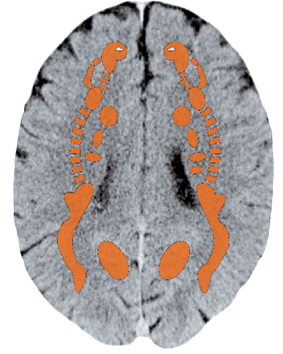
Stretch marks (striae cutis atrophicae)1
| Conflict | Self-esteem conflict of feeling unaesthetic or unattractive on this part of the body. |
|---|---|
| Examples |  A pretty, slender, nutrition-conscious woman of about 40 has very flat breasts and suffers because of it > local self-esteem conflict of feeling unaesthetic > cell degradation in the active-phase, restoration in the repair phase (reddish stripes), the breasts are scarred with stretch marks. (Archive B. Eybl) A pretty, slender, nutrition-conscious woman of about 40 has very flat breasts and suffers because of it > local self-esteem conflict of feeling unaesthetic > cell degradation in the active-phase, restoration in the repair phase (reddish stripes), the breasts are scarred with stretch marks. (Archive B. Eybl) An amateur bodybuilder works hard to build up his upper arms, but he thinks they are still too small = local self-esteem conflict with regard to the upper arms > stretch marks appear. (Archive B. Eybl) An amateur bodybuilder works hard to build up his upper arms, but he thinks they are still too small = local self-esteem conflict with regard to the upper arms > stretch marks appear. (Archive B. Eybl) |
| Conflict-active | Atrophy of the collagenous elastic fibers > weakening or atrophy of the net-like fiber structure of the subcutaneous connective tissue > distention. Consider “handedness“ (right or left) and side (mother/child or partner) or local conflict. |
| Repair phase | Restoration of the fibers, the areas where distention has set in remain unchanged. On the lines where the tissue is torn, repairing, connective tissue is added. The stretch marks are red at the beginning, later they turn pale = condition after the repair phase. Usually a recurring conflict. |
| Bio. function | Strengthening of the connective tissue. |
| Questions | Do my ancestors also have stretch marks, cellulite or lipomas? (Yes > family issue). Why do I wrangle with my external appearance? Was I conditioned by my parents? (Mother struggled with her weight, father criticized mother for this reason)? Did mother have a problem with weight gain during the pregnancy? Are my parents body-oriented/fitness fanatics? (Endurance athletes, always physically fit)? Do I allow myself to be blinded by the beauty industry? Is one’s body not just a shell? What is the meaning of my life? With which kind of a balance do I want to depart from this life one day? |
| Therapy | Determine the conflict and conditioning and, if possible, resolve them in real life if still active. Guiding principles: “I feel good in my skin and am satisfied with my appearance.“ “My body is just a transitional shell. My soul is immortal.” Morning ritual according to Anton Styger (see: p.83). Alkaline diet (p. 65), gymnastics, movement, exercises, cold-warm treatments (sauna, cold effusions). Vigorous massages with camphor, rosemary oil, cinnamon oil. Skin brushing. Bach-flowers: larch. |
Lipoma
| Conflict | Local self-esteem conflict, feeling not aesthetically beautiful at this part of the body. Conflict that the body is not sufficiently padded or protected (e.g., if one bumps into things often). |
|---|---|
| Example |  The 45-year-old, right-handed man is usually very concerned about physical fitness. He goes running and trains at a fitness studio on a regular basis. Then, due to a project at work, he hardly has time for exercise and for two years he neglects his body. When he looks at his out-of-shape arms, he is unhappy about the “deterioration“ = local self-esteem conflict of not finding himself aesthetically pleasing. When the project comes to an end, he decides: As of now, my body will be my first priority. In the following two weeks, a bean-sized lipoma appears on his right underarm = repair phase. (Archive B. Eybl) The 45-year-old, right-handed man is usually very concerned about physical fitness. He goes running and trains at a fitness studio on a regular basis. Then, due to a project at work, he hardly has time for exercise and for two years he neglects his body. When he looks at his out-of-shape arms, he is unhappy about the “deterioration“ = local self-esteem conflict of not finding himself aesthetically pleasing. When the project comes to an end, he decides: As of now, my body will be my first priority. In the following two weeks, a bean-sized lipoma appears on his right underarm = repair phase. (Archive B. Eybl) |
| Phase | Persistent repair – local excessive buildup of new fat and connective tissue, emergence of lipomata and fibroma. |
| Therapy | The conflict is resolved. No measures need to be taken. If new growths appear, determine the conflict and/or trigger(s). Questions: see above. Resolve them with surgery, if visually disturbing. |
Subcutaneous induration (localized scleroderma, morphea)
In this disease, the skin induration of the subcutaneous connective tissue (collagen) becomes hard and inelastic. Affected is usually only a small, coin-sized area. A larger induration, e.g., at joints, can limit movements drastically. The skin is transformed into a “suit of armor.“ If connective tissue in muscles, blood vessels and internal organs harden, then it is called systemic scleroderma.
| Conflicts | Self-esteem conflict: Life or a situation is unbearably hard. One feels defensive – and powerless. |
|---|---|
| Example |  A 50-year-old worker in an underdeveloped country was fired by his company. He cannot find a job and the collapsing social system no longer supports him = unbearable hardship. (Archive of B. Eybl) A 50-year-old worker in an underdeveloped country was fired by his company. He cannot find a job and the collapsing social system no longer supports him = unbearable hardship. (Archive of B. Eybl) |
| Phase | Recurring, persistent-active conflict, degradation and restoration leads to hardening and scarred shrinking of collagenous and elastic fibers (subcutaneous connective tissue). |
| Bio. function | The dermal protection is not enough; the individual needs a suit of connective tissue armor to withstand a certain situation. |
| Questions | Hardening since when? (Conflict beforehand). Which hardship was/am I unable to cope with? What is changing in my life? What stresses me? Which location on the body was affected first? (Indication of the conflict). With what do I associate this body part? What does it represent? Clap test? Am I responsible for the situation? (Yes > take definite steps toward resolution). May I place the problem in God’s hands? May I forgive myself? What has conditioned me in this respect? What were my ancestors like? Which inner changes would be helpful? What can I really/practically change? With whom could/should I speak about this? |
| Therapy | Determine the conflict and conditioning and, if possible, resolve them in real life, so that the SBS comes to an end. Find out where the love is, you will find the solution there. See also: remedies skin p. 351. |
Cellulite (“orange peel syndrome”), lipedema
| Conflicts | Aesthetic self-esteem conflict (see: p.346) and simultaneously a refugee conflict (see: p.277)= syndrome). |
|---|---|
| Examples | ➜ A woman has heavy legs and she thinks this is a problem. ➜ A man has the feeling he is being ridiculed in the sauna because of his belly. |
| Conflict-active | Degradation of fatty tissue (fatty tissue necrosis). |
| Repair phase | Restoration of the fatty tissue, in persistent repair. Excessive buildup of new tissue; running in the background at the same time is an active kidney collecting tubules SBS (syndrome) > storage of fluid and fat = cellulite or lipedema. Usually, a recurring–conflict. |
| Bio. function | Proliferation of adipose tissue, reinforcing the layer of fat, because “fat is beautiful.” A thick individual is beautiful – it is regarded as successful in procuring food. Animals can be thin doing nothing. |
| Therapy | Determine what the self-esteem and refugee conflicts are and, if possible, resolve them in real life so that the SBS comes to an end. Questions: see above. Morning ritual according to Anton Styger (see: p.83). Bach-flowers: larch, crab apple (see: p.59). |
Scar proliferation (keloid)
| Conflict | Local self-esteem conflict with regard to the injured or operated spot. Fear before/of an operation. |
|---|---|
| Example |  A woman is very unhappy that her abdomen needs a surgical procedure – local self-esteem conflict. An ugly overgrowth of scar tissue forms = persistent repair. (Archive of B. Eybl) A woman is very unhappy that her abdomen needs a surgical procedure – local self-esteem conflict. An ugly overgrowth of scar tissue forms = persistent repair. (Archive of B. Eybl) |
| Conflict-active | Cell degradation in the subcutaneous connective tissue at the location of the scar. |
| Repair phase | Persistent repair: Restoration of the tissue, excessive, new formation of scar connective tissue; the keloid remains. |
| Bio. function | Strengthening of the scar. |
| Therapy | Prevent a keloid: If you are injured and/or are going to have an OP, go forward with full confidence. Get surgery on the injury. Do not argue with fate. Reconcile with what has happened. Do not doubt the recovery. Scar treatment with camphor, cinnamon oil. Energetic interference suppression by acupoint-massage. Cayce: Massage with peanut oil and camphor oil in equal parts. Using these measures, I may observe a significant improvement of keloids. See also: remedies skin p. 351. |
Subcutaneous tissue hardening (systemic scleroderma/sclerosis)
In this disease, the skin becomes hard and inelastic due to hardening of the subcutaneous connective tissue (collagen). Usually, only a small area is affected, often only the size of a coin.
A larger spread, e.g. at joints, can restrict movement drastically.
The skin is transformed into “body armor.”
If the connective tissue in muscles, blood vessels or internal organs also hardens, this is referred to as systemic scleroderma.
| Conflict | A devaluation conflict, that life or a situation is unbearably hard. One feels unprotected, helpless and left at the mercy of fate. |
|---|---|
| Example |  A Greek man in his mid-50s is laid off by his company. He can’t find a job and the collapsing social system in Greece isn’t offering him any support either = unbearable hardship. (Archive B. Eybl) A Greek man in his mid-50s is laid off by his company. He can’t find a job and the collapsing social system in Greece isn’t offering him any support either = unbearable hardship. (Archive B. Eybl) |
| Phase | Recurring, persistent active conflict. Hardening and reinforcing through the scarring shrinkage of subcutaneous connective tissue (collagen and elastic fibers). |
| Bio function | The protection provided by the dermis is not enough. The individual needs connective tissue armoring to withstand a certain situation, or life itself. |
| Questions | Hardening since when? (Conflict beforehand). What hardship was/am I unable to withstand? What has changed in my life? What is stressing me? Which location on the body was affected first? (Indication of the conflict). What do I associate this part of my body with? What does it represent? Clap test? Am I responsible for the situation? (Yes > implement a definite plan to resolve the conflict). May I place it in God’s hands? May I forgive myself? What conditioned me in this direction? What made my ancestors tick? What inner changes would heal me? What practical/real changes can I make? Who can/should I speak about this with? |
| Therapy | Determine and resolve the conflict, causal conditioning and belief structures, so the SBS comes to an end. Look for where the love is – that’s where the resolution is. Complete recovery/healing probably only possible within the first months. See also skin remedies, p. 351. |
Skin tags (soft fibromas, fibroma molle, fibroma pendulum)
Skin tags are soft protuberances of the skin. They consist of soft connective tissue and are usually found around the armpits, eyes, and neck. Their size ranges from a few millimeters to about two centimeters.
Their distinction from genital warts: Genital warts remain small (1-2 mm), occur only in the genital area and are ectodermal (see pages 307 and 319).
The fact that these harmless fibromas usually only develop from middle age onward is an indication of the conflict described below.
| Conflict | Local devaluation conflict in relation to the affected part of the body. One is not satisfied or feels uncomfortable with the area of the body in question. Often involving aesthetic doubts or annoying points of friction. |
|---|---|
| Example | a A young man doesn’t use any deodorant. When he undresses in the evening, his gets a nose full of his own pungent underarm odor. = Devaluation conflict with focus on his armpits. He develops several skin tags. After he begins washing himself regularly (three times a day), the fibromas disappear. (Archive B. Eybl) |
| Phase | Persistent healing: Excessive build-up of subcutaneous connective tissue > formation of skin protuberances = fibroma. Little fibromas fall off when the conflict is resolved. Larger ones remain. |
| Therapy | See therapy p. 346. Dab with apple vinegar or tea tree oil 3x a day. |
Connective tissue tumor (fibrosarcoma, fibroblastic sarcoma)
Fibrosarcomas manifest themselves as swellings or bumps on the legs, arms or torso.
According to CM, fibromas (see above) and fibrosarcomas only differ in their classification as benign or malignant.
However, since their appearances are completely different, one must assume we are dealing with two different “diseases.”
Fibromas are completely harmless, while fibrosarcomas can become dangerously large and are also problematic from our perspective.
| Conflict | Devaluation conflict, that one felt this part of the body was unprotected/left at the mercy of fate. |
|---|---|
| Examples |  A woman walked shin-first into the open door of her dishwasher. She was instantly filled with pain and rage, because her husband had left the door open once again. A fibrosarcoma later appeared at this exact location. (Archive Antje Scherret) A woman walked shin-first into the open door of her dishwasher. She was instantly filled with pain and rage, because her husband had left the door open once again. A fibrosarcoma later appeared at this exact location. (Archive Antje Scherret)  As a boy, a man who is now 35-years-old found his parents’ constant arguing and eventual divorce very difficult to handle. Later in life, he avoids all disharmony – he cannot stand it when anyone is fighting. A large fibrosarcoma developed over his solar plexus – a “protective cushion.” (Archive B. Eybl) As a boy, a man who is now 35-years-old found his parents’ constant arguing and eventual divorce very difficult to handle. Later in life, he avoids all disharmony – he cannot stand it when anyone is fighting. A large fibrosarcoma developed over his solar plexus – a “protective cushion.” (Archive B. Eybl) |
| Phase | Recurrent conflict: Connective tissue growth at the affected location = fibrosarcoma. Formation of lumps/boils, i.e. cushioning. |
| Bio. function | One builds themselves a protective cushion/buffer, so that the blows/hardships of life are more tolerable in the future. |
| Note | Among cats, fibrosarcomas are the second most common form of skin cancer. These tumors occur more frequently in places where the animals have been given an injection (“injection-related fibrosarcoma”). = Indication of the conflict described above. |
| Questions | What happened at the affected location? (Impact, fall, fear) Why do I react so sensitively to the issue of protection/being unprotected? What childhood conditioning lies behind this? Do/did parents/ancestors have similar symptoms? (Indication of a substitution conflict) Which unresolved ancestral issue am I carrying? (Inquire into their life story and look for parallels – often, this is where the deeper cause lies). |
| Therapy | Determine and resolve the conflict, tracks and causal conditioning, so the SBS comes to an end. If the conflict remains permanently resolved, the tumor will stop growing. The increase in tissue (the cushioning) will remain. Don’t wait too long to have surgery, because larger tumors must be removed. According to protocol, it will be “pretreated” with chemo/radiation. |
1 See Dr. Hamer, Charts pp. 60, 71
Dandruff, hair loss (alopecia totalis), spot baldness (alopecia areata)1
According to CM, hair loss in men is caused by a high testosterone level. Then, it must be young men (high testosterone), who are affected. However, from the point of view of the 5 Biological Laws of Nature, the frequent loss of hair in men is somewhat unclear: why should only men suffer from separation conflicts of the head, but not women?
Many kinds of medication can lead to hair loss: chemo, “the pill,“ painkillers, antirheumatics, blood thinners, cholesterol-lowering drugs, etc. Where medication is not involved, there is no doubt that patchy or sudden hair loss is caused by a conflict.
| Conflict | 1. Separation conflict with respect to the affected area (head). One does not feel accepted. Hairs are our antennae: “You send your hair out to get your dream man.” (Uwe Eggers) 2. According to Frauenkron-Hoffmann: We must show that we are smart. Many modern men identify themselves with their intellect – a modern ailment. Women don’t seem to suffer from worries like these. 3. According to the “New Community of Philosophers”: Men experiencing hair loss do not express their inner feelings (their soul’s female attributes). Indeed, they often don’t even recognize them – as opposed to women. Sharing our feelings with others is important for our development. The reward is a beautiful head of hair. The conscious sensation of every moment is a part of this (those who don’t know sorrow cannot know joy). |
|---|---|
| Example |  The now 20-year-old, married, right-handed woman suffers her first separation conflict with her head, when she is just 8 years old, when her beloved grandmother dies suddenly. Her grandmother had the habit of pressing the child‘s head against her abdomen. She liked that a lot. A second, even stronger separation conflict happened a year ago, when her two very best friends suddenly turned away from her in a very distressing manner. All attempts to restore contact failed. She begins to lose her hair in patches – about 70% of her head is bald = conflict active-phase. (Archive B. Eybl) The now 20-year-old, married, right-handed woman suffers her first separation conflict with her head, when she is just 8 years old, when her beloved grandmother dies suddenly. Her grandmother had the habit of pressing the child‘s head against her abdomen. She liked that a lot. A second, even stronger separation conflict happened a year ago, when her two very best friends suddenly turned away from her in a very distressing manner. All attempts to restore contact failed. She begins to lose her hair in patches – about 70% of her head is bald = conflict active-phase. (Archive B. Eybl) A six-year-old girl is banned from her parents‘ bed. This causes a separation conflict with regard to the head. She loses hair. (Archive B. Eybl) A six-year-old girl is banned from her parents‘ bed. This causes a separation conflict with regard to the head. She loses hair. (Archive B. Eybl) I myself, like my father, lost my hair relatively early. Also like my father, I’m all about showing off my smarts. Not expressing our emotions is also an issue for us. (Archive B. Eybl) I myself, like my father, lost my hair relatively early. Also like my father, I’m all about showing off my smarts. Not expressing our emotions is also an issue for us. (Archive B. Eybl) Itchy dandruff on the scalp: A 12-year-old girl broke her leg and was in a cast for six weeks. Showering was difficult and she stopped washing her hair. > Due to the budding vanity accompanying her at puberty, the girl suffered a biological separation conflict: Symptoms of dandruff, itching. At that point, the girl developed a track with regard to washing her hair: When her hair was freshly washed, everything is okay. However, the next day her itching and dandruff would begin and progressively get worse = recurring separation conflict, “I feel unwashed.” She lived with this for 30 years. As she learned about the 5BN, she realized she couldn’t allow the situation to go on like it was. Within two days, her symptoms disappeared permanently. (Archive Antje Scherret) Itchy dandruff on the scalp: A 12-year-old girl broke her leg and was in a cast for six weeks. Showering was difficult and she stopped washing her hair. > Due to the budding vanity accompanying her at puberty, the girl suffered a biological separation conflict: Symptoms of dandruff, itching. At that point, the girl developed a track with regard to washing her hair: When her hair was freshly washed, everything is okay. However, the next day her itching and dandruff would begin and progressively get worse = recurring separation conflict, “I feel unwashed.” She lived with this for 30 years. As she learned about the 5BN, she realized she couldn’t allow the situation to go on like it was. Within two days, her symptoms disappeared permanently. (Archive Antje Scherret) |
| Conflict-active | Reduced metabolism in the hair’s roots in the epidermis. Hair loss, dry scalp with poor blood circulation, dandruff (= indication of conflict activity). Usually a recurring conflict. |
| Bio. function | Loss of sensitivity lets the missing or unwanted skin contact be forgotten. One shows their head. |
| Repair phase | Increased scalp metabolism, swelling, reddening, itching, new hair growth with a 2 – 3 month delay. The rest of the scaly skin falls away, no new dandruff forms. |
| Questions | Hair loss since when? (Conflict before that) Was there a separation, harsh rejection or another sort of shock? Why do I associate this with my head? (E.g., stroked, massaged, caressed or the opposite: struck/injured)? Otherwise, do I have to show my head/prove my intellect? (E.g., career training/performance). What value does intellect have in our family? Do I identify strongly with this? What am I if I’m not clever? Was there an event with relation to my head/hair that affected/moved me? Which change is needed in my consciousness? Which new attitude should I develop? |
| Therapy | Determine the conflict and conditioning and, if possible, resolve them in real life if still active. At least a 4-week course of treatment: Apply pounded, white cabbage leaves and drink the fresh juice. (See S. R. Knaak, Die kreisrunde Haarausfall, Ennsthaler 2010). Rub in tea from wormwood, nettle, burdock root, boxwood roots. Head massage with sesame oil and essential oils of thyme, rosemary, cedar. Cayce: Massage with “crude oil“ (stone oil or petroleum, see p. 68), head massage, exercise, internal cleansing with alkaline nutrition. Eat brown millet regularly. Enemas. Schindele’s Minerals. |
1 See Dr. Hamer, Charts pp. 119, 131
Gray hair
When pigment (melamine) production slows, the hair turns gray; a normal part of the aging process. However, unusually early or sudden graying is certainly related to a conflict.
| Conflict | Brutal separation conflict, usually with a generational aspect (family, descendant issues). |
|---|---|
| Examples |  The 49-year-old single mother of three children has to go to the hospital for an operation. She promises her children she will call right after the surgery. When she wakes up from the anesthesia, she is in the intensive care unit. She asks the nurse what time it is. She is told that the surgery was the day before = brutal separation conflict from her children. Within three days, her hair turns gray = active-phase. (Archive B. Eybl) The 49-year-old single mother of three children has to go to the hospital for an operation. She promises her children she will call right after the surgery. When she wakes up from the anesthesia, she is in the intensive care unit. She asks the nurse what time it is. She is told that the surgery was the day before = brutal separation conflict from her children. Within three days, her hair turns gray = active-phase. (Archive B. Eybl) A 40-year-old woman who wants to have a child goes to her gynecologist for an examination. He tells her that she will never have children = strong separation conflict with a generational aspect. Overnight, her hair turns snow-white. (Archive B. Eybl) A 40-year-old woman who wants to have a child goes to her gynecologist for an examination. He tells her that she will never have children = strong separation conflict with a generational aspect. Overnight, her hair turns snow-white. (Archive B. Eybl) |
| Conflict-active | Cell degradation, slowdown of metabolism in epidermis – lower layer (melanophore layer) > reduced melamine production > graying of the hair. |
| Bio. function | Increased sunlight transparency, so that more light (warmth, information, knowledge, wisdom) can penetrate. > “Comfort and wisdom through the rays of the sun.” “The wisdom of age.” |
| Repair phase | Restoration of the melanophore layer, restoration of hair color. |
| Questions | What happened when the hair suddenly went gray? (Event shortly before). Was there stress in the family? (E.g., fighting with children/relatives, accusations because of inheritance)? What should I change on the inside and outside to affect a resolution? |
| Therapy | Determine the conflict and conditioning and, if possible, resolve them in real life if still active. |
- Natural stimulants like light (sunbathing in moderation), water, rain, wind.
- Vitamin B complex in yeast products (brewers yeast).
- Vitamins E and A in cold-pressed vegetable oils, especially linseed oil.
- Cod liver oil (see p. 68).
- Colloidal Gold.
- Cayce: alkaline diet, pay attention to elimination (colon) and circulation (gymnastics), eat two almonds a day, massages, rubbings with olive oil, olive oil soap for cleansing.
- Tea for the skin (internally or externally): barberry, birch leaves, blackberry leaves, sage, mullein, chamomile, speedwell, chicory.
- Baths and rubbings with effective microorganisms (EM: p. 66).
- Hydrogen peroxide (H2O2) 3% strength.
- Seawater full baths or alkaline baths.
- Natural borax, externally.
- Hildegard of Bingen: thyme, quince, red beets.
- Black salve: Great remedy for immediate removal of skin tumors with active cell division processes (“malignant“) instead of surgery. Only for people with high tolerance for pain and steady nerves: order at www.cernamast.eu.
- For inflammations: chamomile, healing earth, clay, acetic acid/healing earth compresses, cooked potato compresses, Schuessler Cell Salts No. 1, 3, 11.
- Miracle Mineral Supplement from Jim Humble (see p. 68).
- Open sores, badly healing wounds: Spread with blossom honey, curly-leaf cabbage compresses, marigold salve, comfrey salve or propolis salve.
- Skin care: Olive oils and other oils from the kitchen, refined with a bit of ethereal oil, instead of expensive and unhealthy chemical cocktails from the cosmetics industry.
Olive oil would be ideal but its smell and short shelf life are problematic. Alternative: sunflower seed oil. The inexpensive, heat-extracted oils have the advantage over the cold-pressed oils (which are actually better) in that they keep well and don‘t become rancid so quickly.
Olive oil would be ideal but its smell and short shelf life are problematic. Alternative: sunflower seed oil. The inexpensive, heat-extracted oils have the advantage over the cold-pressed oils (which are actually better) in that they keep well and don‘t become rancid so quickly.
All experience reports on the organ system “Skin, Hair and Nails” from the International Report Archive:
| Author | Title and Overview | Keywords | ||||
|---|---|---|---|---|---|---|
 | 2025/09/15   Epidermis – separation conflict, having said something inappropriate, unpleasant consequences due to what was said plus subsequent conflict ‘Wanting to get rid of herpes’ | Separation Conflict | ||||
 | 2025/09/08    | separation conflict | ||||
 | 2025/09/08    | separation conflict | ||||
 | 2025/09/07   Case of allergy resolved after a separation conflict, treated with ocular reprogramming, resulting in disappearance of symptoms. | Separation conflict, skin, respiratory mucosa, allergy, ocular reprogramming | ||||
2025/06/05   A man was out and about with his grandson. The little boy suddenly had to pee really urgently, but needed help opening his pants. When the pants were finally open, the pee came flying through the air like an unrestrained water hose | Panaritium | |||||
2025/03/24   This documentary presents 15 individuals who were diagnosed with cancer by conventional medicine and who examined the causes of their symptoms according to the model of the so-called 5 Biological Laws of Nature and overcame them.  | Colon cancer, bone cancer, breast cancer, skin cancer, testicular cancer, pancreatic cancer, cervical cancer | |||||
 | 2025/03/13   A young woman reports: At the beginning of the year, I spontaneously flew to Switzerland with my sister-in-law for five nights. We wanted to spend a few days skiing and hiking there, but we only flew with hand luggage, so we had very limited clothing.  | |||||
 | 2025/03/05   A customer had very close contact (sometimes physical) with a dog that lived in the same house. This contact was forbidden. The basal cell carcinoma developed as a result. After recognizing the conflict and subsequently resolving it, the basal cell carcinoma began to shrink and disappeared. | Skin, skin cancer, basal cell carcinoma | ||||
 | 2025/02/25   Vanessa's first psoriasis symptoms started in 2018. It started on her right knee and continued on her other knee, elbows and scalp in 2019 ... | |||||
 | 2025/02/18   Melissa Sell in an interview with Alexander Radburnd, who has suffered from skin rashes/eczema more or less all his life. | Neurodermatitis | ||||
2025/02/17   Marja Nieuwveld from Switzerland and the Netherlands was diagnosed with superficial basal cell carcinoma on her right breast ... 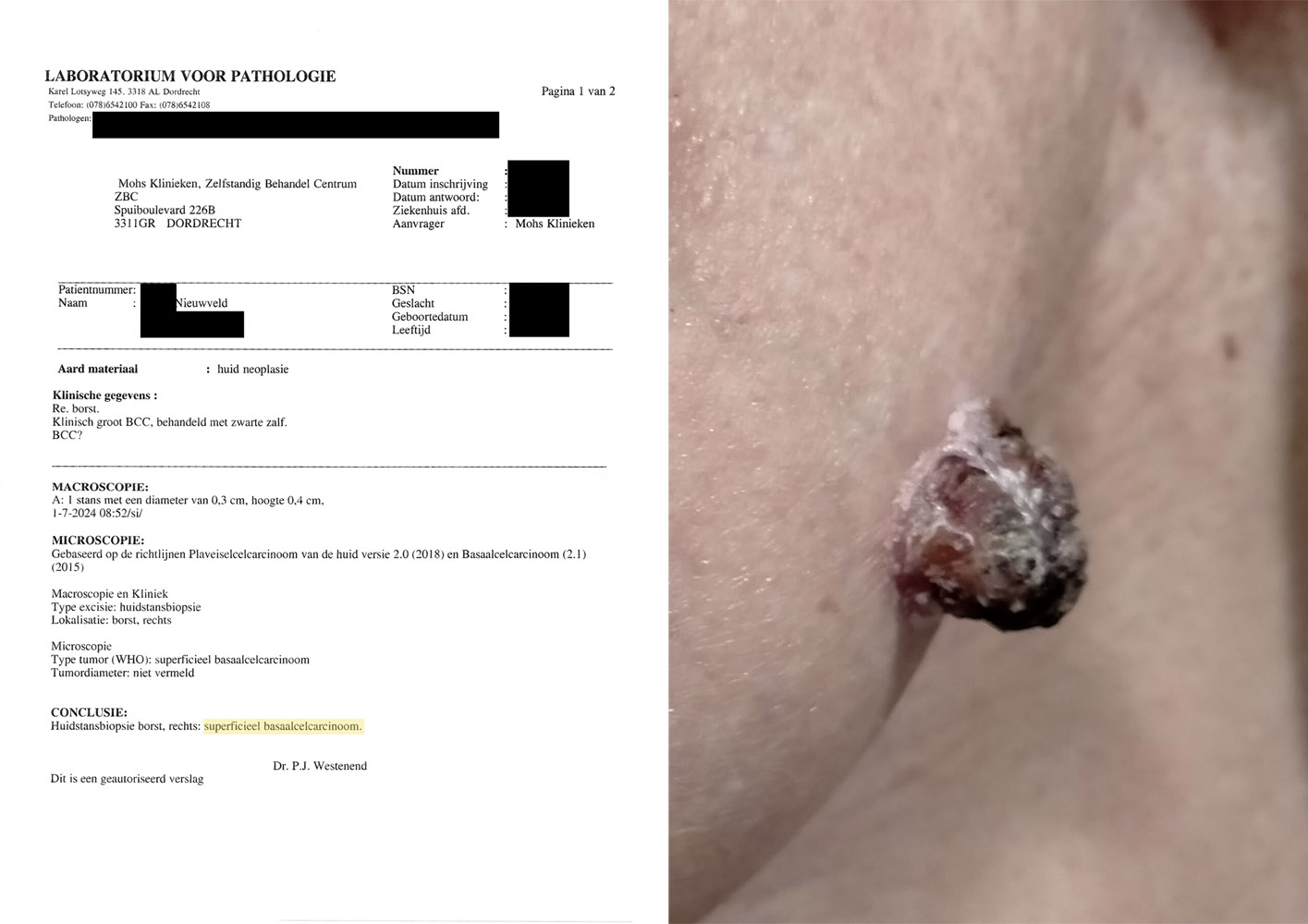 | Skin cancer | |||||
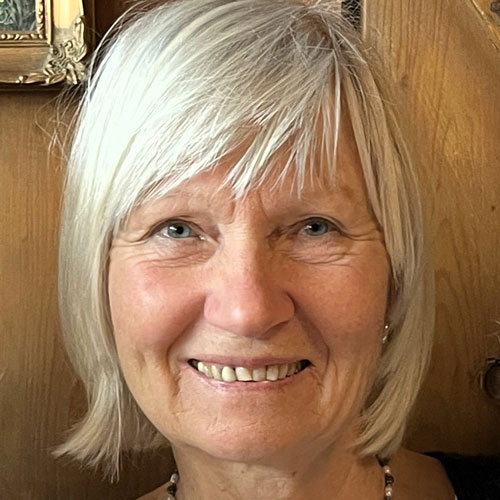 | 2024/12/13   It was 1978, a difficult year for me. I went to the gynecologist for a routine examination, there were no abnormalities – until he told me: “You have vitiligo on your vagina, that is the white spot disease, there is nothing that can be done about it. It is spreading, incurable. | |||||
 | 2024/11/28   A few years ago, I had a patient (36 RH) who had massive skin abnormalities. It was genital herpes, shingles, psoriasis, purpura, all recurring, and all in the area of the genitals and lower abdomen and inner thighs, on both sides ... | Genital herpes, shingles, psoriasis, purpura, syphilis | ||||
 | 2024/11/25   My daughter, then 8 years old, suddenly had skin rashes on her inner thighs, inner knees and heels. | |||||
 | 2024/11/21    presence of unpleasant contact. partner grabbed by the neck. track worked - in childhood stepfather pressed against the wall grabbing by the neck 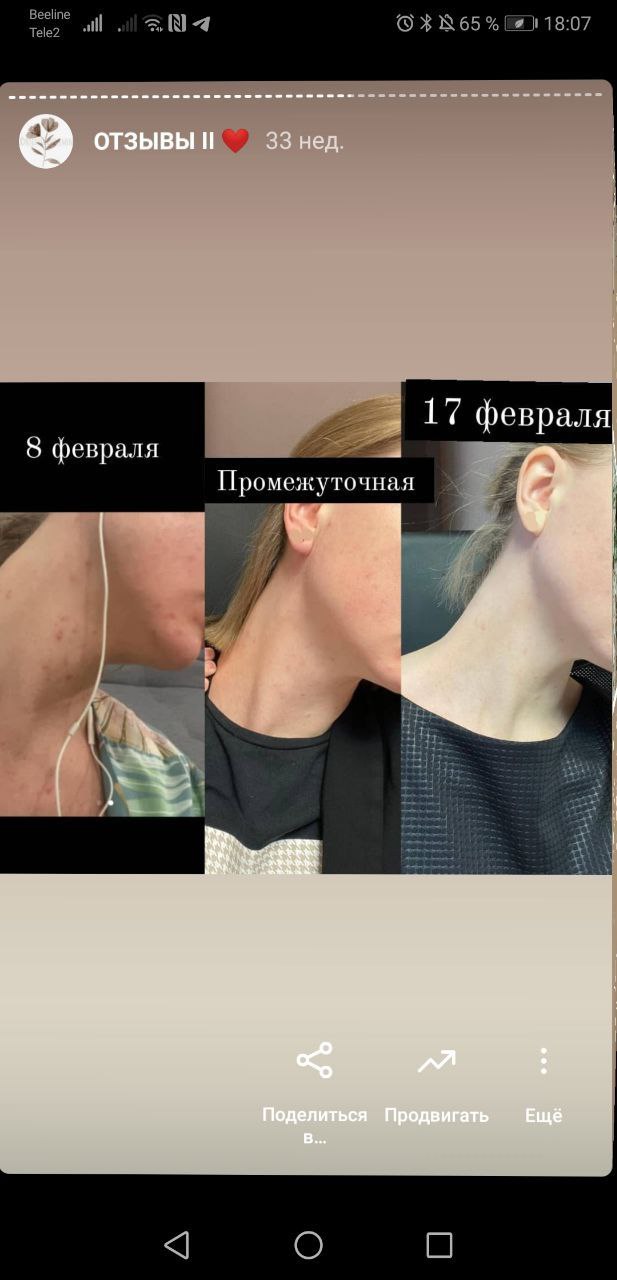 | конфликт разделения и грязи | ||||
 | 2024/11/18   conflict of separation. work on perception of the figure of the authoritarian father 1 individual session. 5 days later, skin became clear at 90% then add. t1 session in group therapy, to consolidate and remove the trigger like a parents apartment 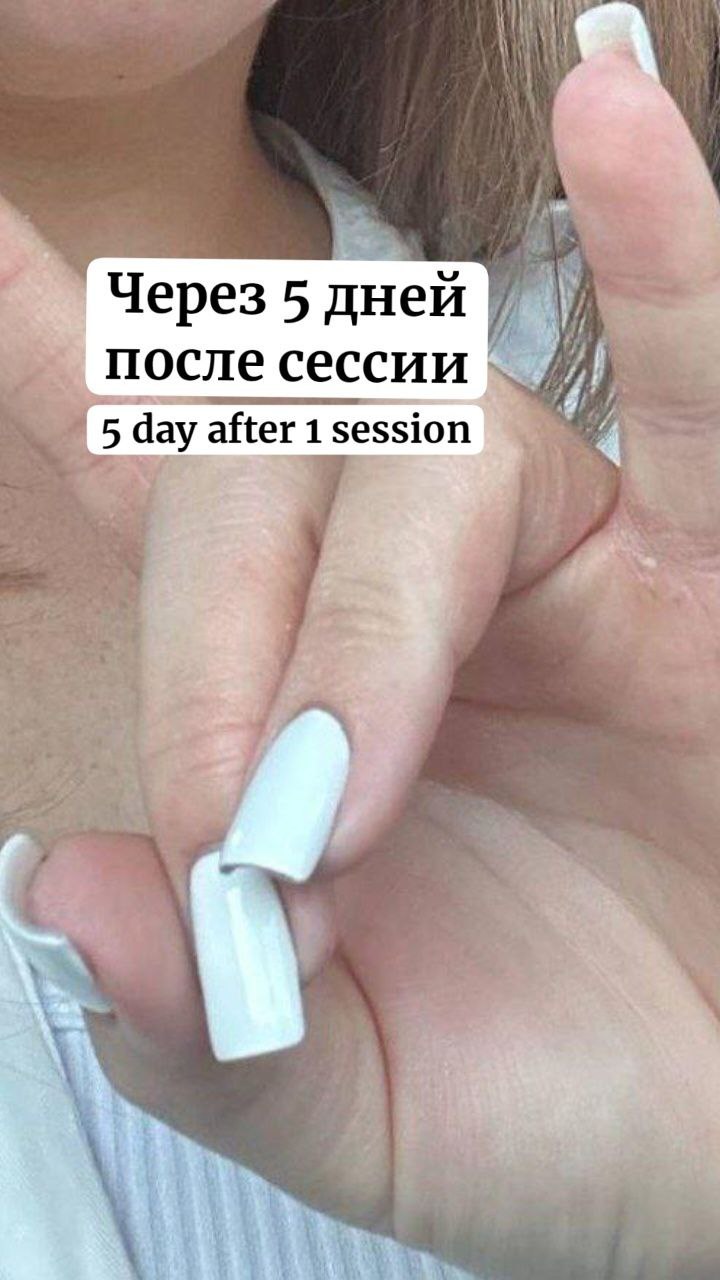 | Сonflict of separation | ||||
 | 2024/11/11   It was skin cancer on my back, which had started to heal when I recognized the conflict. I went to the doctor for the operation. She said there was nothing left to see. | |||||
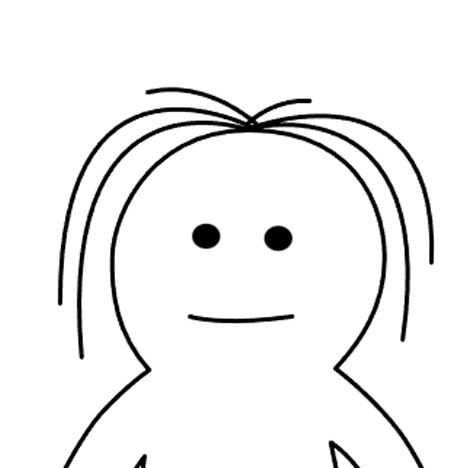 | 2024/11/06   In February/March 2023, we packed our home into boxes and put it into storage. The last big moving day, where all the heavy furniture and co. were to be driven from A to B, was just around the corner and more and more friends/helpers canceled at short notice; partly because of a cold ...  | |||||
2024/10/09   In spring 2024, my wife said to me: “What's that under your left eye, you haven't had that before”? I had actually noticed it unconsciously before, but I thought I had had it for years or decades, probably because it had simply grown very slowly over months or years ... 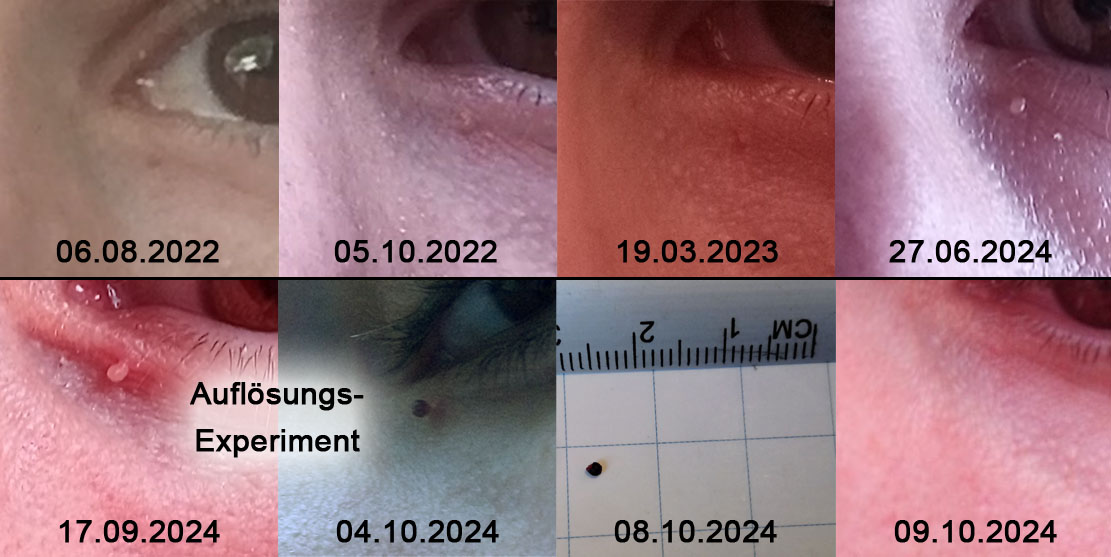 | Fibroma | |||||
 | 2024/09/24   From time to time I want a kebab. Because I eat it with my hands, some sauce sometimes runs down my face. That's what I thought, because whenever I wanted to wipe it off, there was no sauce to be found. | |||||
2024/09/14   When I was 14, I was delighted to get a piercing in my ear and wore an earring with pride. In my mid-twenties, I wanted a second one, went to the jeweler and got one pierced ... | ||||||
2024/09/11   Mrs. S has been intensively involved with the 5BN for several years. At the beginning of the year, her sister had a health problem. As Mrs. S wanted to help her sister and saw the 5BN as a good starting point, she sent her the relevant information and an offer of help to start with via her cell phone.  | Attack/contamination conflict | |||||
2024/09/07   A three-year-old boy started nose-picking, much to the displeasure of his parents. All well-intentioned advice and pleas to refrain from doing so (especially in public) failed ...  | Attack/contamination conflict | |||||
 | 2024/08/23   My client has worked as a volunteer for 27 years, investing a lot of time and energy. In the spring of the year before last, his integrity was called into question because he didn't go with the flow when it came to the C-crisis. In the end, he resigned from his voluntary work ... | |||||
 | 2024/07/06   For weeks, even months, I had been looking forward with mixed feelings to an announced, probably necessary gum graft in the lower jaw (to stabilize a certain implant) ... | |||||
 | 2024/05/28   On Saturday I was chopping firewood with my husband. I was only wearing very light fabric sneakers. Suddenly he threw a big chunk of wood right in front of my foot and I was really scared at that moment because I was really worried about my toes... | |||||
 | 2024/05/07   Every year, as soon as I observed the leaves falling from the trees, I would get rough and dry skin on the exterior surface of my hands for months and could not sleep well in my bedroom (only in the living room). | Allergy, dry hands, sleep problems | ||||
 | 2024/04/05    This report is about the importance of letting yourself know that the situation that led to the symptoms will not happen again. I told myself directly: it will not happen again, because the people who were involved will no longer be around me. 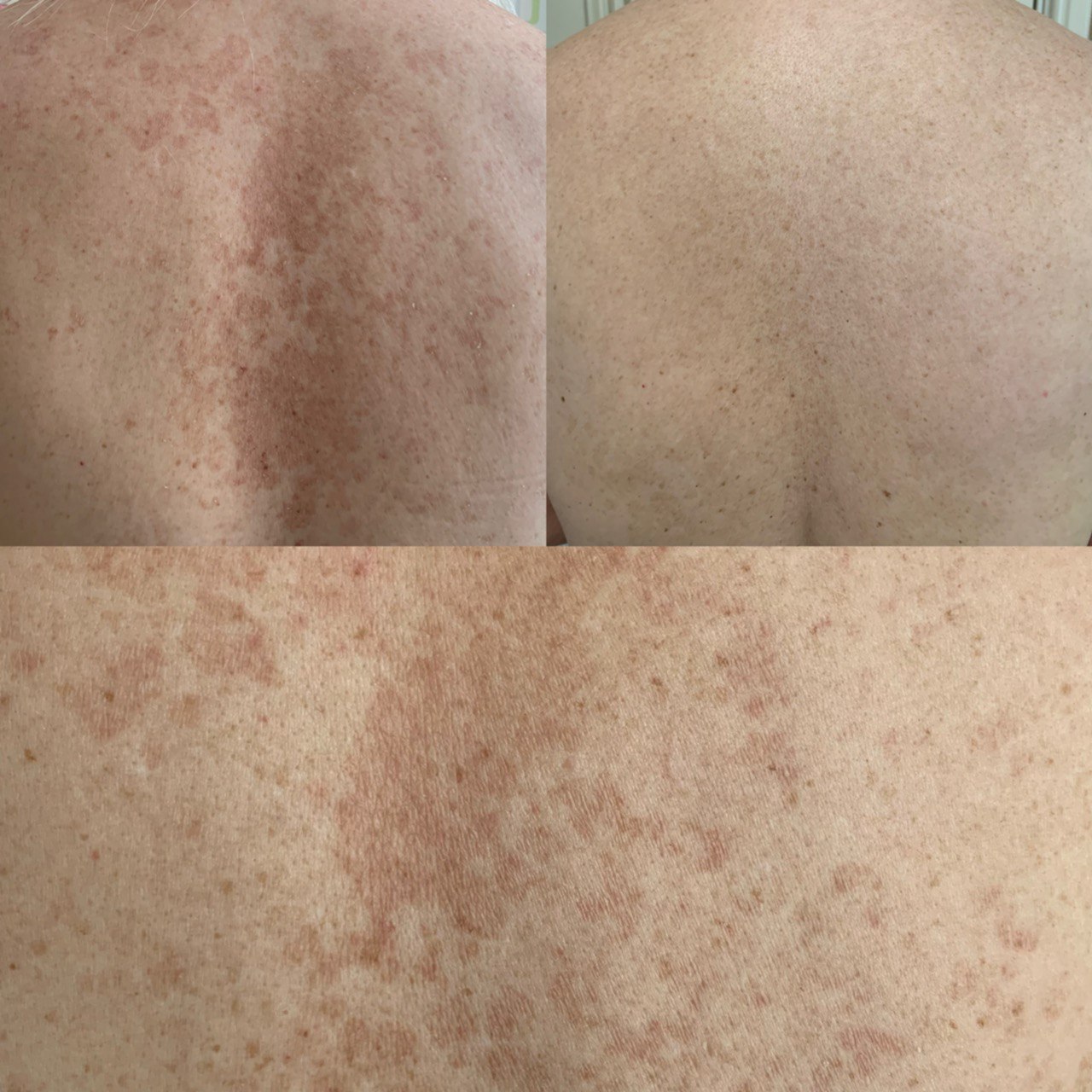 | |||||
2024/03/26   Formation of small brown spots on the breast due to a mother's rough, painful breastfeeding experiences. And disappearance of these due to later, more pleasant experiences. | ||||||
 | 2024/03/21   My daughter (7) spent the whole summer running around barefoot in the countryside and at some point stepped on thorns. Four warts formed on her feet, one of which was very large ... | |||||
 | 2024/03/10   Sweaty feet for years without interruption from about 1993 to about 2009 (date of resolution no longer known) I cannot remember the origin, it developed "somehow" in my life (perhaps I wore unsuitable shoes) Daily recurrence and resolution, so to speak Termination of the splint through realization of the biological mechanism. | besmirching dirt feet stink | ||||
 | 2024/01/07   Our 10-year-old daughter loves to be gently cuddled/caressed by us when she goes to bed/goes to sleep. At some point in the summer, my wife also gave her a full body massage ... | |||||
 | 2023/11/23   The symptom began as a child with a small spot on the right arm and spread over the years. Today the spots are on the inside of the arms and from the axilla down to the chest. | |||||
 | 2023/08/28   My trauma back then was my friend who fell from the top of the haystack passing me into the depths. I wouldn't have been able to hold on to him without falling with him | Paralysis, MS, varicella | ||||
 | 2023/08/06    This is the case of an acquaintance of mine who was passing through my house. I used to even envy her because her skin was always good. But this time red spots covered her face and neck. She told me that this has been going on for more than six months now. Efforts and use of different remedies have not brought improvement... 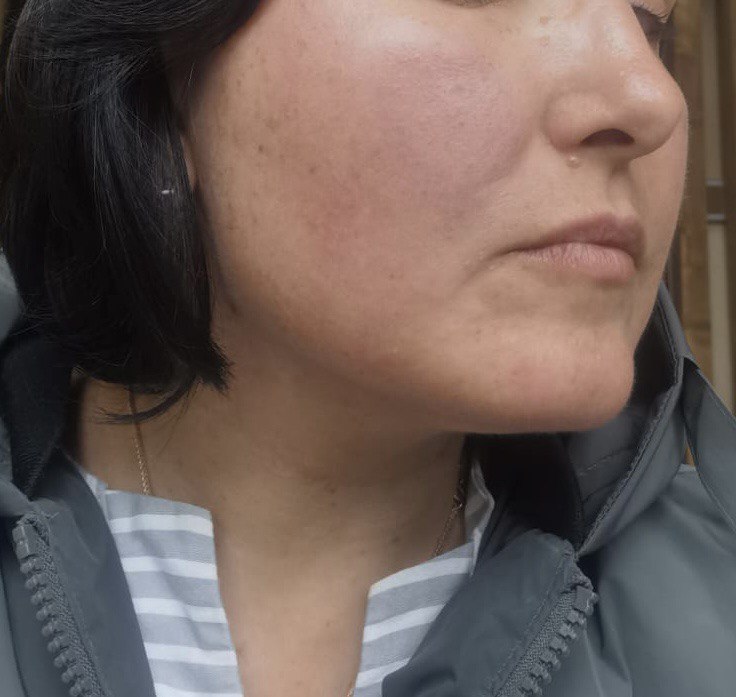 | Separation conflict | ||||
 | 2023/08/04    A student of my course asked me to help her with her symptoms. The woman thought it was a so-called fungus on her right foot (toes), it had been there for about three or four weeks. She has used the bathroom with other family members, no one has anything like this, her left foot is also fine. So the contagiousness theory has once again been defeated... 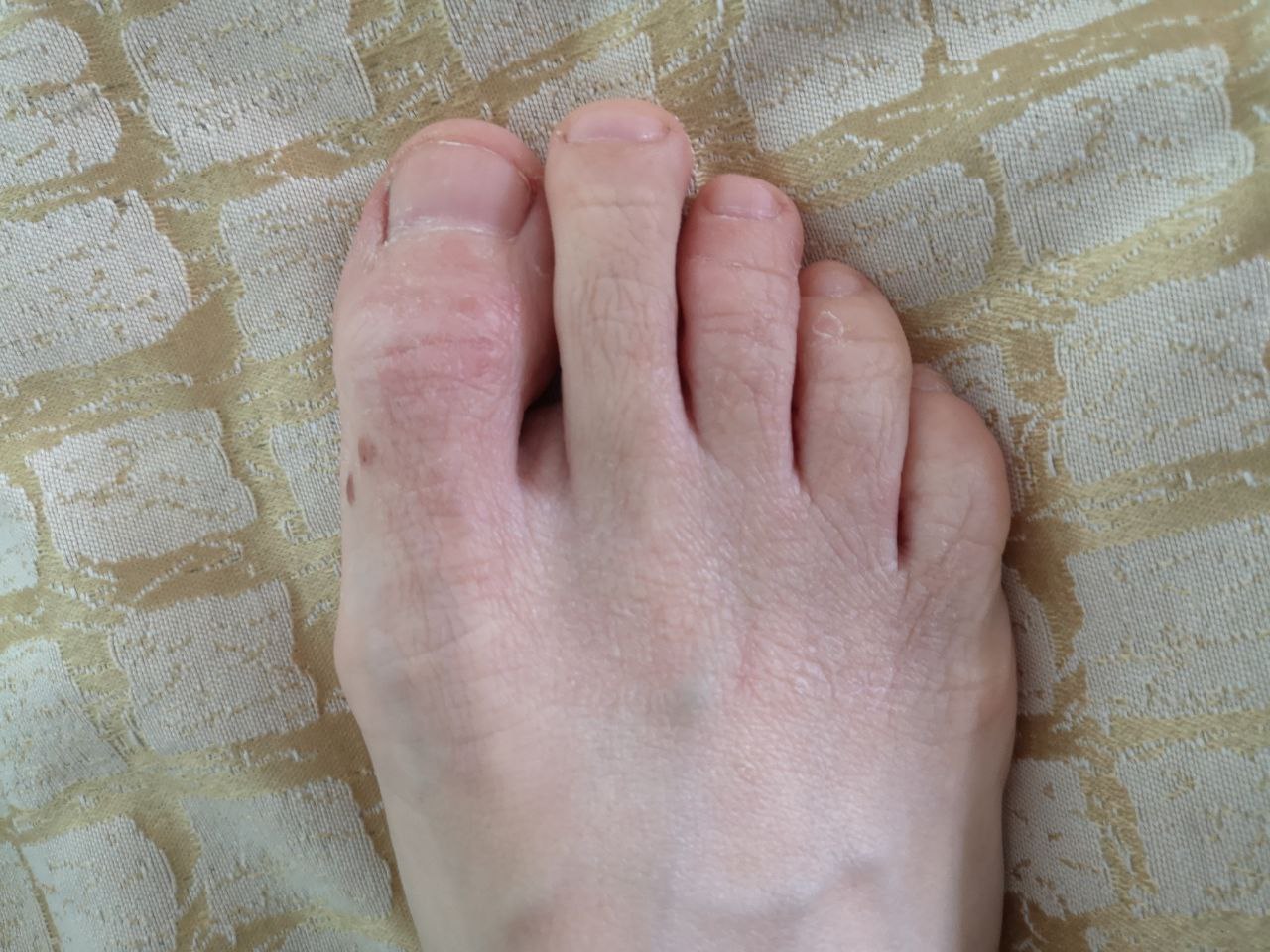 | Separation conflict, ectoderm | ||||
 | 2023/07/29   Could it be that I am premenopausal? | |||||
 | 2023/07/16   I always had cracked skin between my toes in the summer. For a long time I had no idea what to do and everything I tried didn't help ... | |||||
 | 2023/06/24   For several months I had been suffering from severe nail fungus on both feet. (Laboratory confirmed) I applied various creams and tinctures to my toes and toenails every day, but it didn't get any better. I pondered back and forth as to what conflict could be present here ... | |||||
 | 2023/06/07   Breaking off contact with an important person for 7 months. Then successful contact again with subsequent onset of symptoms (small red spots around the chest, abdomen and back). The spots appeared a little later, developed for 3 weeks and then went back again in 2-3 weeks until they disappeared completely. 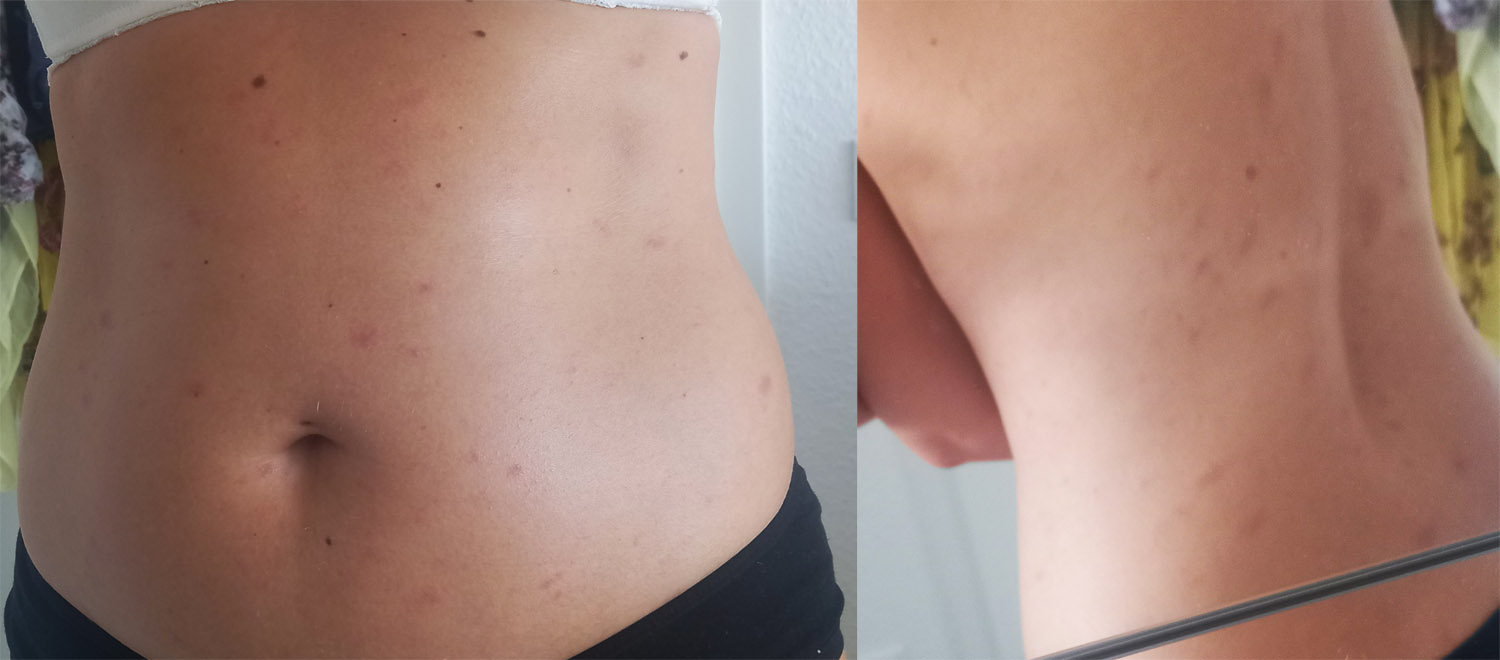 | |||||
 | 2023/05/21   After wearing velvety-soft silk scarves, the client developed reddening of the skin with itching on the neck area, specifically on the back of the neck, not on the front. This skin reaction lasted for a day or two and then disappeared until she wore a silk scarf again. The phenomenon also occurred when she wore a pearl necklace on much rarer occasions. | epidermis | ||||
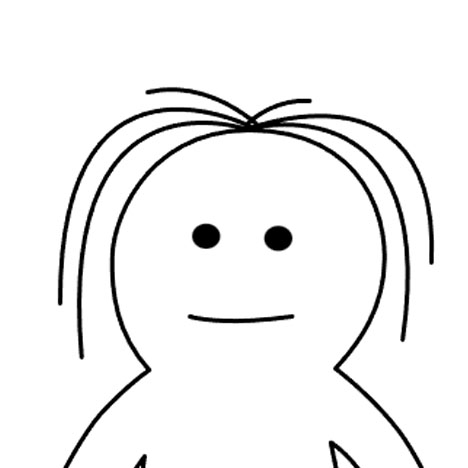 | 2023/03/06   Increasing reddening of the skin and scaling on the forearm after my budgie bit me there by surprise. Resolution by recognizing the causal connection.  | |||||
2023/03/05    Drie jaar geleden waste de moeder voortdurend natte stoffen luiers en walgde ze enerzijds als ze die aanraakte, maar anderzijds wilde ze deze situatie niet met de kinderen. Het resultaat was een extreem droge, gebarsten en pijnlijke huid aan de buitenkant van haar handen. Onlangs was er weer een soortgelijke situatie, waarna het symptoom binnen een paar uur weer opdook en dus zeer goed geverifieerd is als de oorzaak. 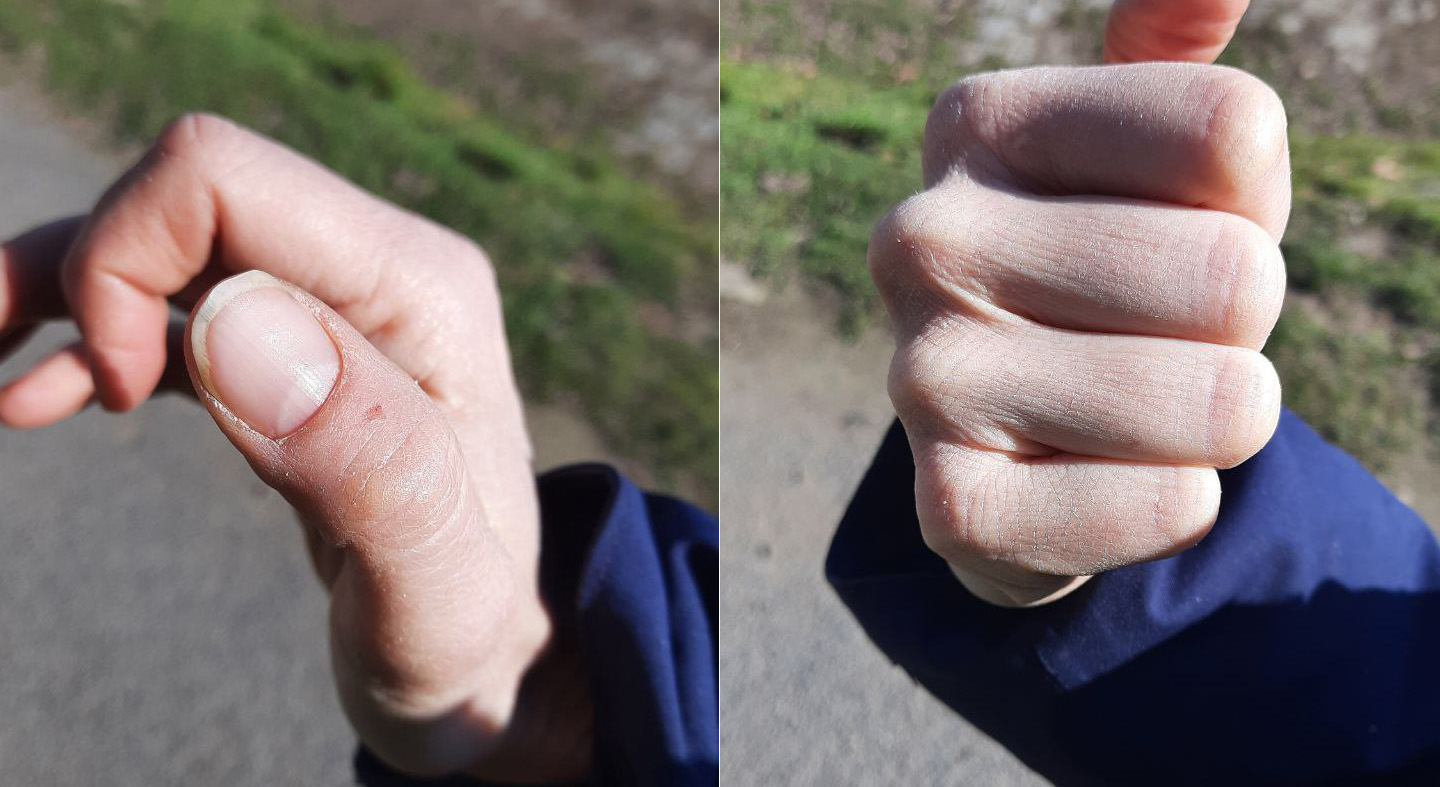 | ||||||
 | 2023/02/19    Na aankoop van nieuwe schoenen van een bepaald merk ontstond er kort na het aantrekken een branderig gevoel op de zolen van beide voeten. Het branderige gevoel ging weg, maar in de dagen daarna verschenen er wratten op de bal van beide voeten. | |||||
 | 2023/01/06   Wife, 70, about two and a half years ago our daughter broke off contact with her original family for the second time out of the blue: “We'll come back another time.” Radio silence! ... | |||||
 | 2022/12/23   Thick blackheads on the outside of both upper arms, which became terribly inflamed, pus-filled spots, hurt and wouldn't heal. Due to severe mold infestation, which spread everywhere in the newly purchased apartment and which she perceived as an attack / defilement. | |||||
 | 2022/12/04   I shared the office with a colleague, which was actually a converted 2-room apartment. The small company grew and within a short time, 3 new employees were hired ... | |||||
2022/10/06    Dit was de meest intense en duidelijkste conflictactiviteit, die we tot nu toe bij onze zoon hebben kunnen waarnemen als gevolg van obsessief denken. We waren blij, dat we zo gericht te werk konden gaan om het ZBS zo snel - en daardoor zo probleemloos - door de conflict-opgeloste fase te loodsen. | ||||||
 | 2022/08/20   My boy, about 6 years old at the time, was playing with the neighbor's boy in the garden. I told him I was taking his little brother to the farm (just a meadow away from our house) and asked if he wanted to come with me or stay at home. He said he would stay with the neighbor ... | Separation conflict, school sores | ||||
 | 2021/06/17    Een vrouw werd op een ochtend wakker met verlamming aan de linkerkant van haar gezicht: Deze aangezichtsverlamming eindigde precies zoals voorspeld drie weken na het oplossen van het conflict en het begin van de verlamming. Een casusbeschrijving op het Internat. Congres van de A.L.B.A. 2011 | |||||
 | 2021/06/17    Een geval van dermatitis bij een jongetje, waarbij de uitslag precies op de plek verscheen waar het kind het laatst was aangeraakt toen het werd overgedragen, gepresenteerd door therapeut Marco Brazzo op het Internat. Congres van de A.L.B.A. 2011 | |||||
 | 2021/06/17    Wat haaruitval bij paarden veroorzaakt, uitgelegd aan de hand van twee casestudies op het Internat. Congres van de A.L.B.A 2011 | |||||
 | 2021/06/17    Nadat ik een weekend bij kennissen had gelogeerd, ontdekte ik maandagochtend een kleine "herpes simplex labialis" op mijn linker onderlip (koortslip). Dit leende zich voor een casusanalyse volgens de vijf biologische natuurwetten. Dit model was mij toen al enkele jaren bekend. | |||||
 | 2021/03/12    In dit verslag worden verschillende symptomen gecombineerd, omdat ze bijna allemaal de schadelijke gevolgen waren van 20 jaar huwelijk met een heimelijke narcist. Na een tweede, zeer gelukkig huwelijk, ontwikkelde ik symptomen van "borstkanker" na de plotselinge dood van mijn vrouw. | |||||
 | 2020/10/18   A friend and I noticed that her 9-month-old baby, who was still breastfeeding, had a reddish rash in two places: on the top left of her back and on the right side of her bottom … | Separation conflict, skin rash | ||||
 | 2020/02/23   A woman developed a small (1 cm) melanoma where clothing labels were placed and scratched at the back of her neckline. She knew the 5BN and suspected the connection. | Contamination conflict | ||||
 | 2020/01/26   I had a girlfriend who broke up with me (I didn't know about Germanic medicine at the time). My hair was thinning on the right side and the back of my head. So a separation conflict with blame that was still active. | Separation conflict, Haarausfall | ||||
 | 2020/01/05   Reduction of ectodermal skin on the palm of the hand due to unwanted touching/activities with this hand. Resolution of symptoms by stopping the activity. | Separation conflict, ulcers | ||||
 | 2019/10/13   A woman has had an itchy and flaky scalp for over 30 years. After she recognized the cause of the problem, the symptoms disappeared within two days due to awareness. | Separation conflict, scalp | ||||
 | 2019/08/11   The father wants to kick the butt of his son, who is a department manager in his company, for months because he is not performing his duties conscientiously. During this time, the plantar wart forms under the left bunion/toe. | Plantar wart | ||||
 | 2019/06/19   Severe itching between little toes after stepping on a slug. | athlete‘s foot | ||||
 | 2019/06/10   Development of warts because the boy had to go to a kindergarten even though the parents did not want him to. Conscious conflict resolution and the warts fell off when it was discussed with the child. | Wart | ||||
2018/03/21     Een paar heeft een intieme relatie gekregen na aanraking op het topje van de vinger. Toen de betrokkene kort daarna weg moest, associeerde hij dit als een sterk scheidingsconflict op deze plek. Kort nadat ze elkaar na een paar dagen weer zagen, kreeg hij plotseling enorme pijn aan precies deze vinger - alsof iemand er met een hamer op had geslagen. | ||||||
2018/01/30     Betrokkene had sinds haar jeugd herhaaldelijk fasen van sterke, onaangenaam pijnlijke en jeukende roodheid van de huid doorgemaakt en in dit verband verschillende diagnoses gekregen, zoals eczeem, neurodermitis, allergie voor wol/verf/chloor/zon,.... Onmiddellijk na haar aanzoek volgde een bijzonder sterke, laatste conflictoplossende fase met ernstige symptomen. | ||||||
2015/05/23     Bezoedelingssthema aan de duim door contact met fecaliën tijdens het verschonen van de baby.  |
